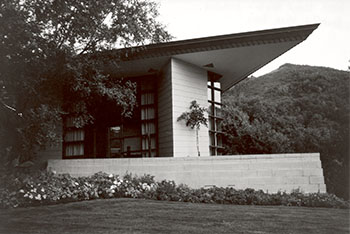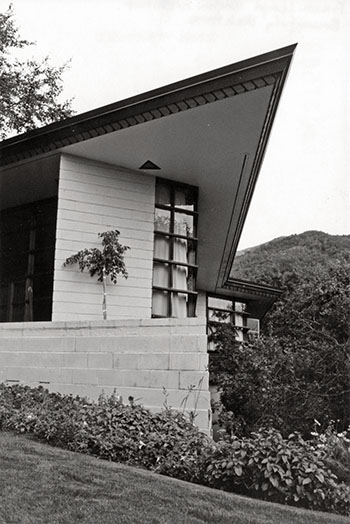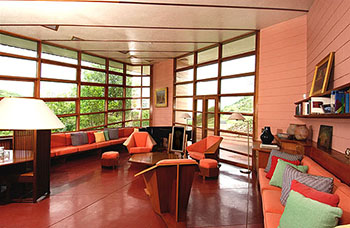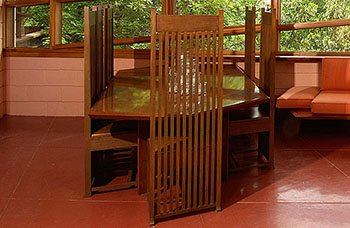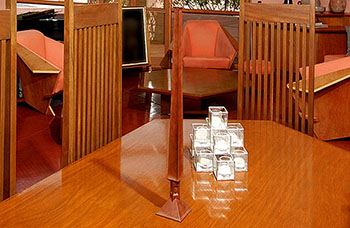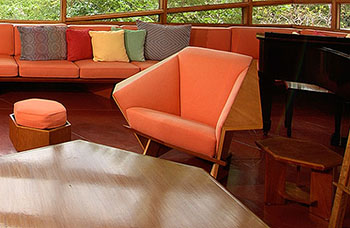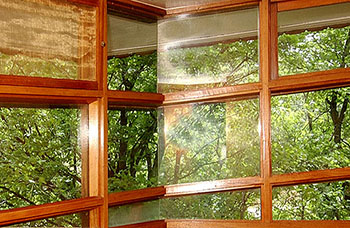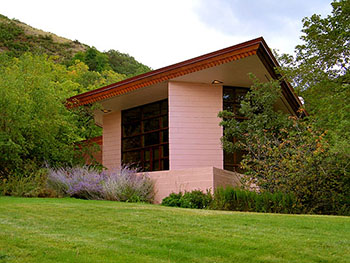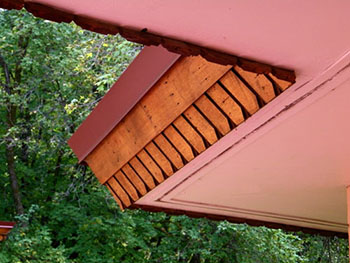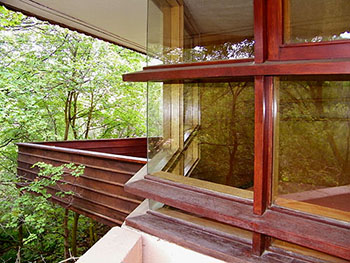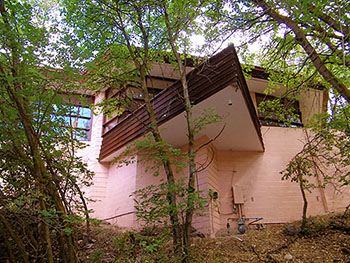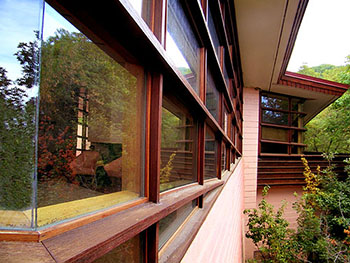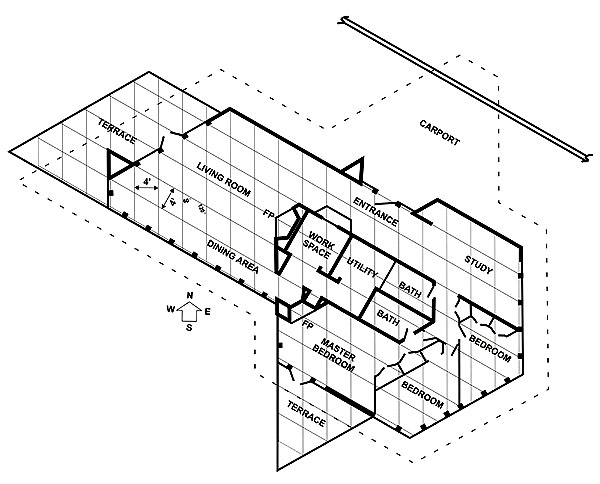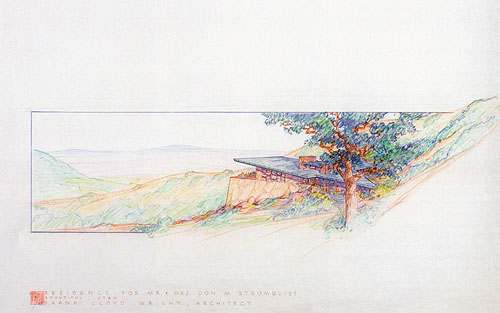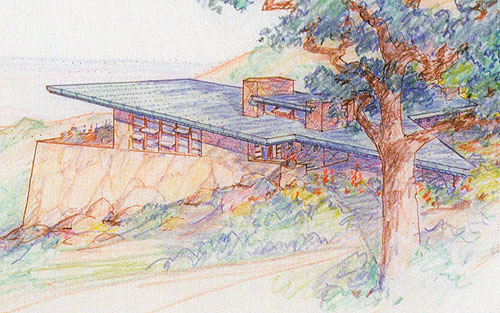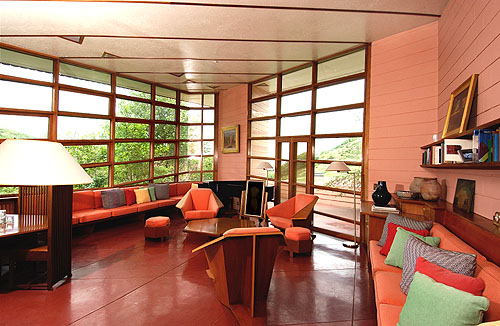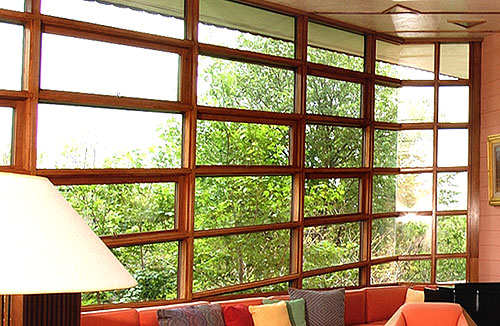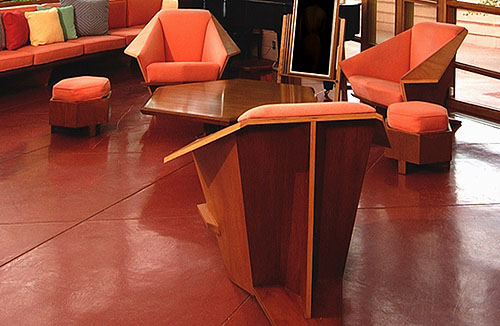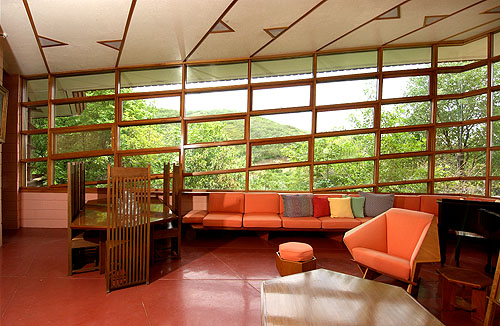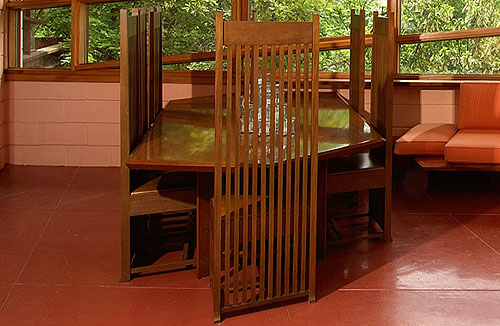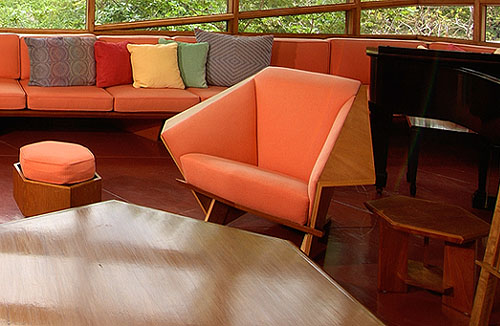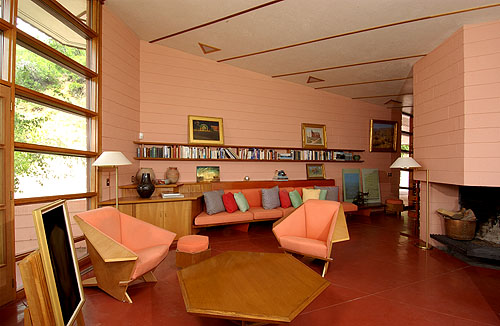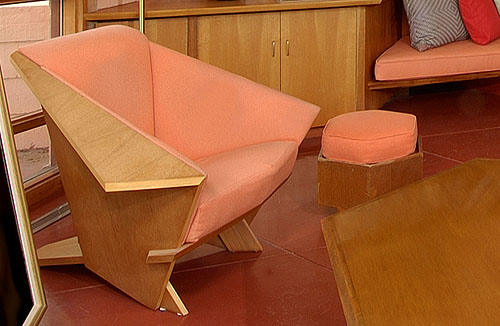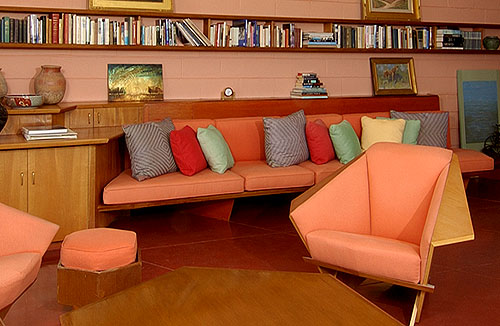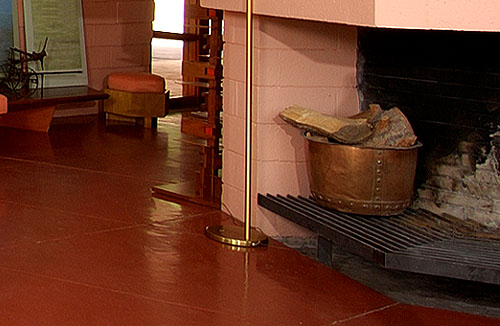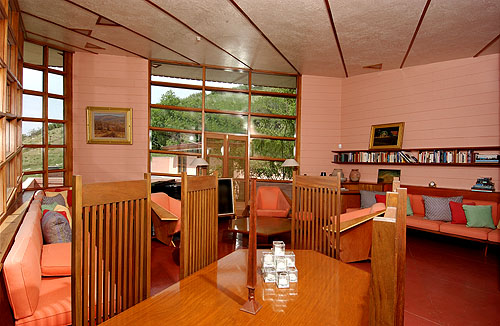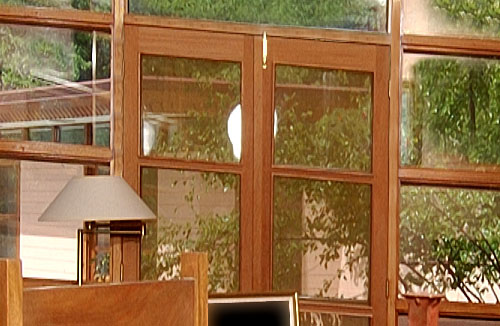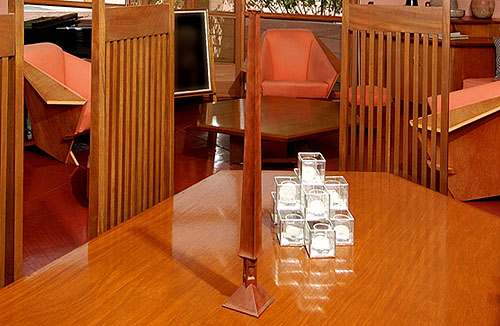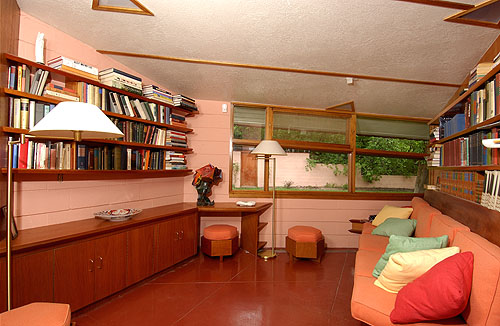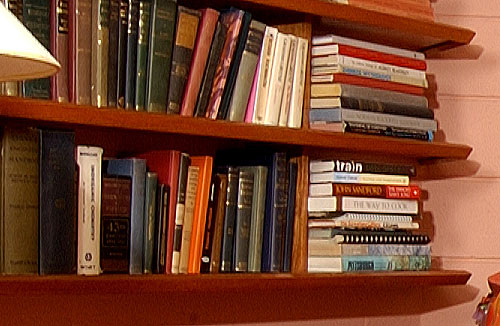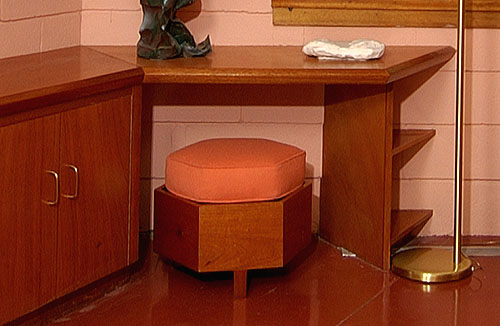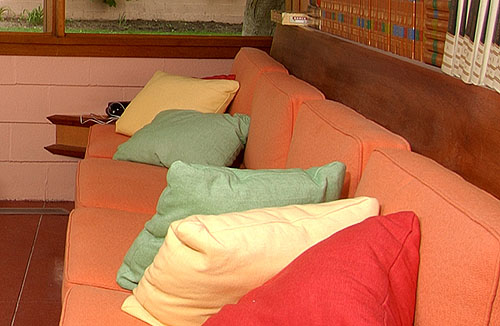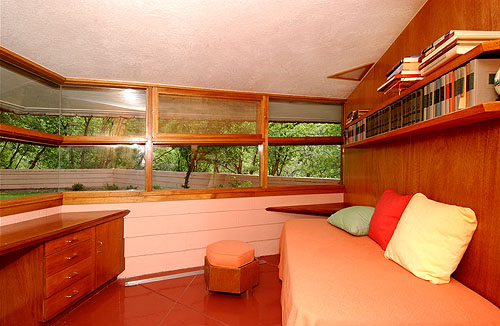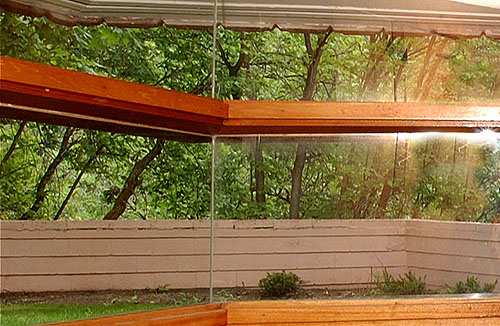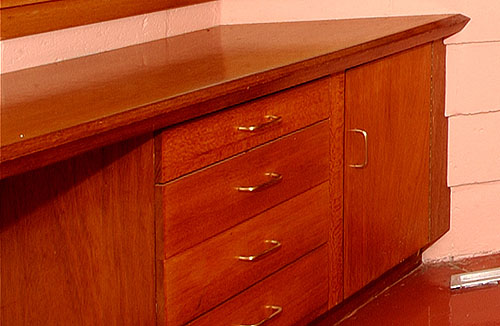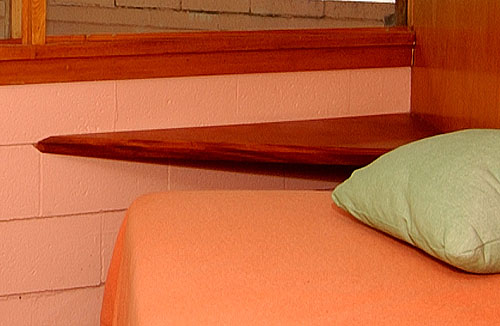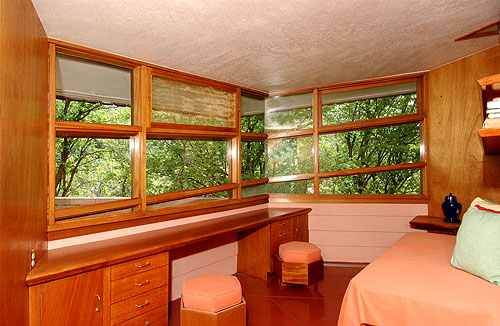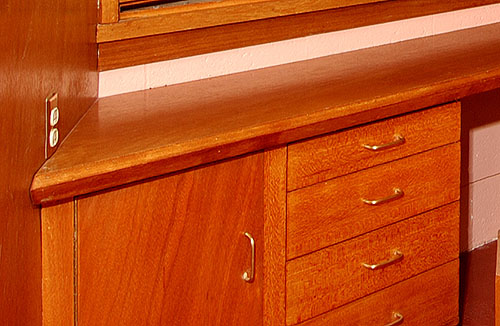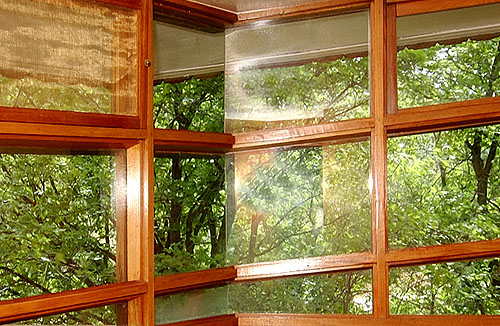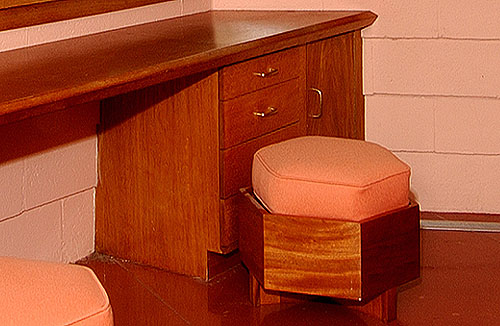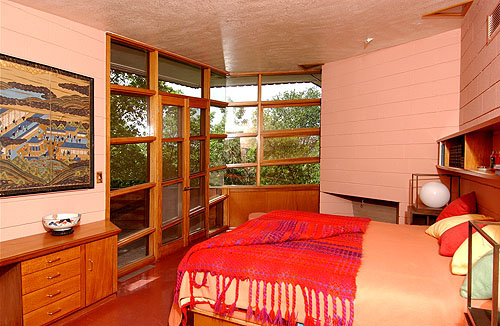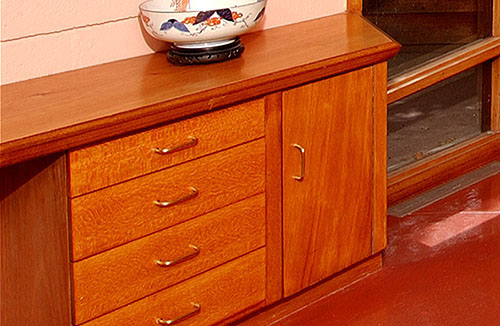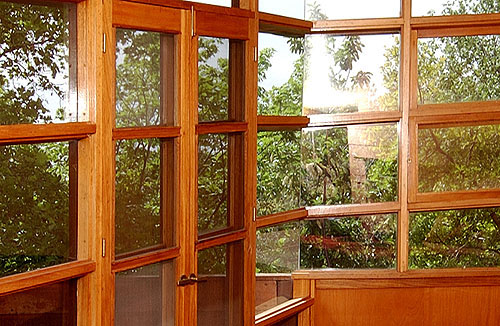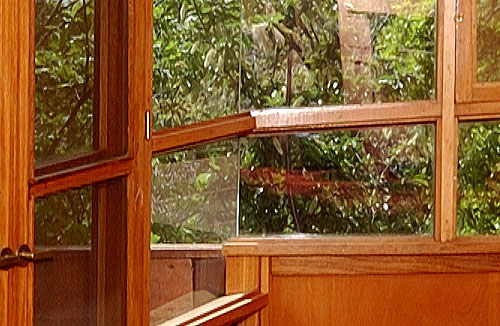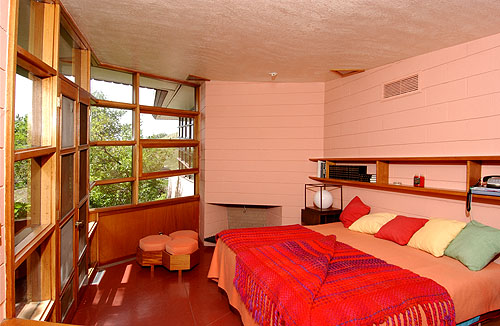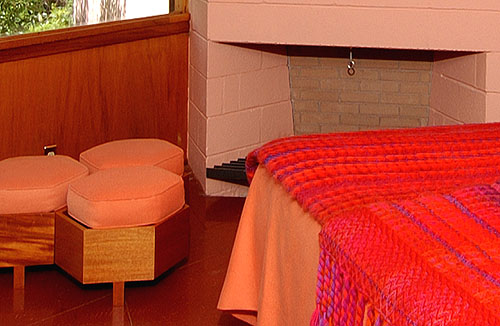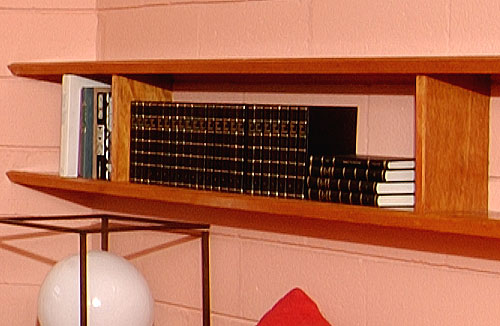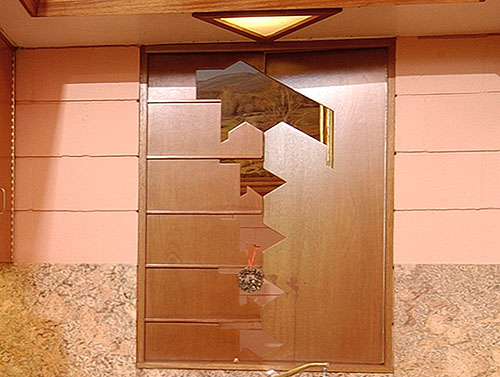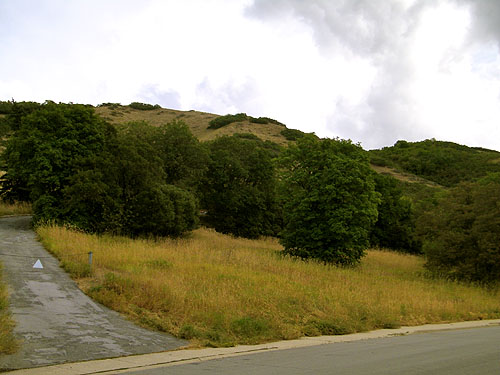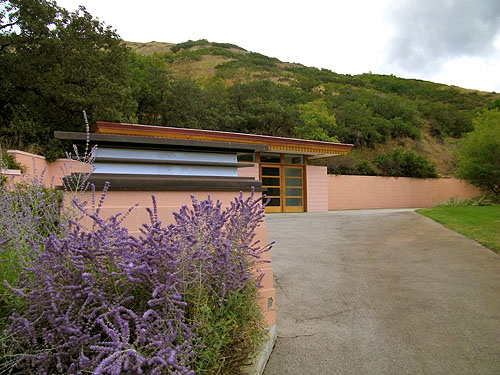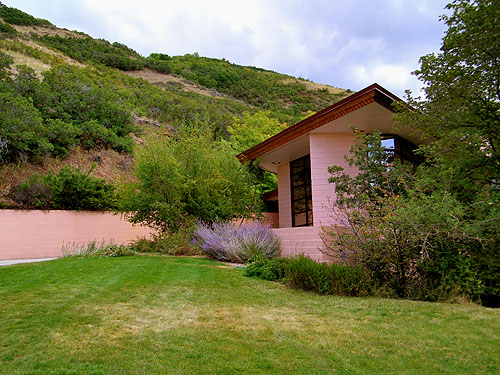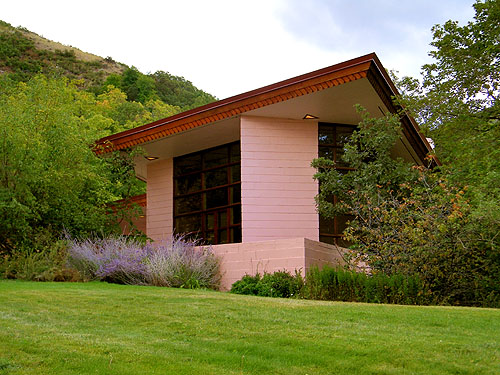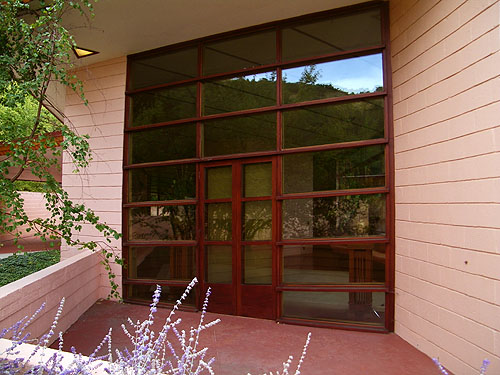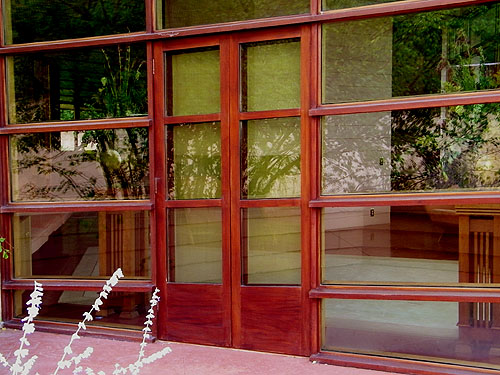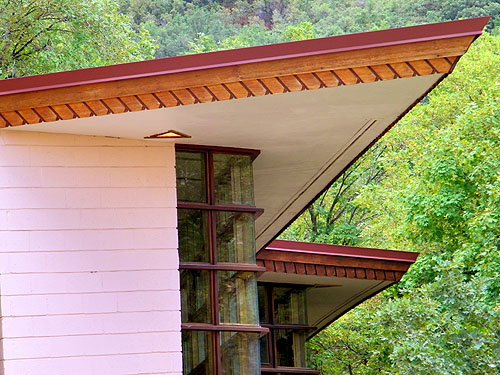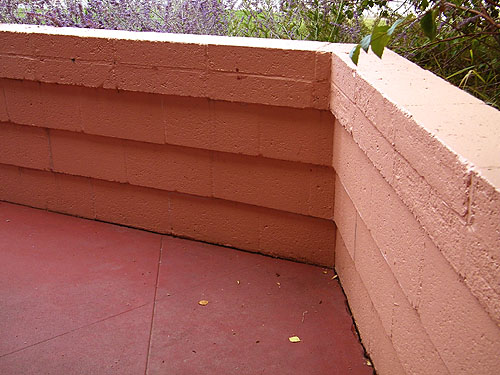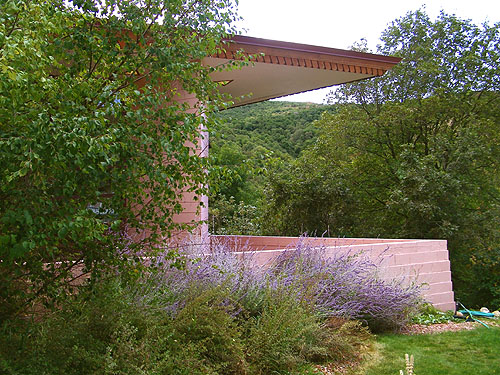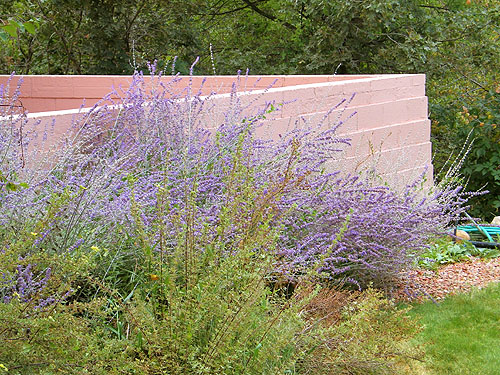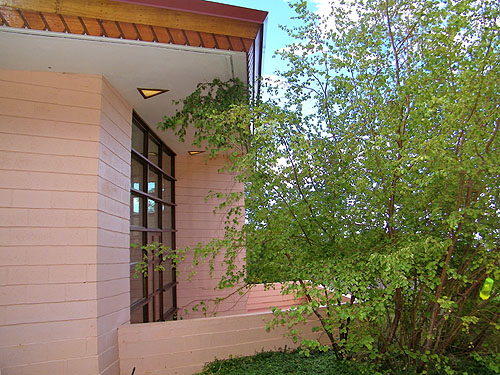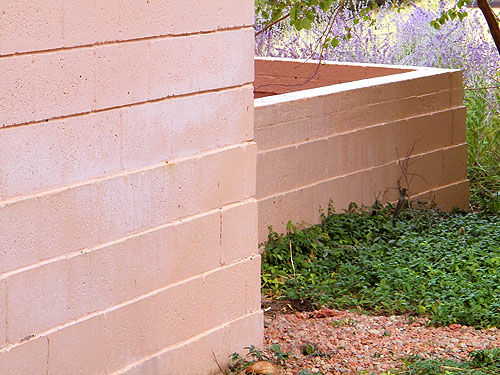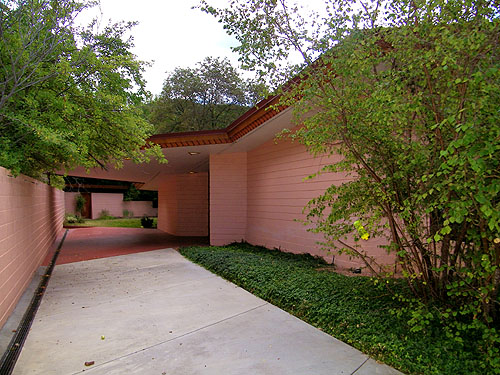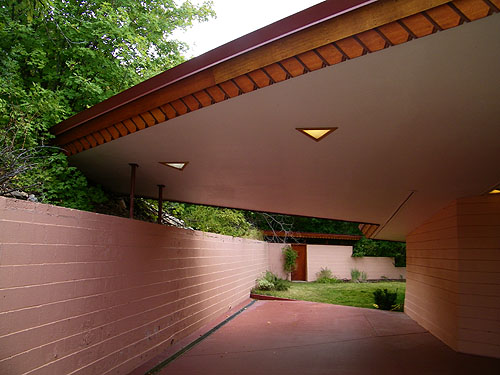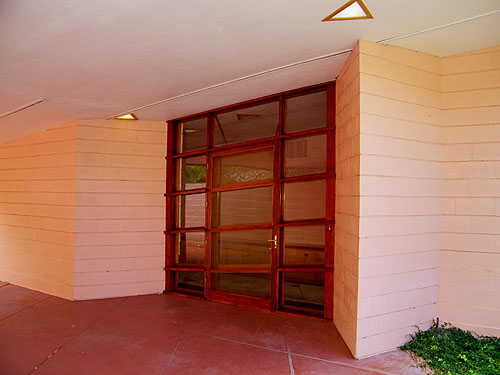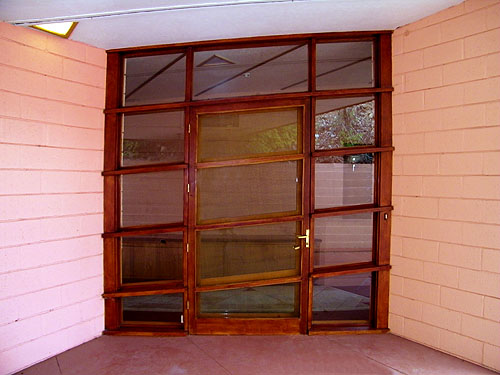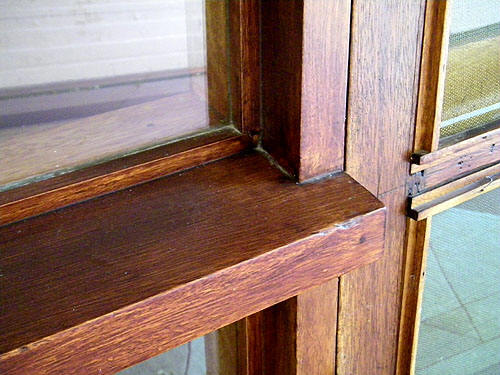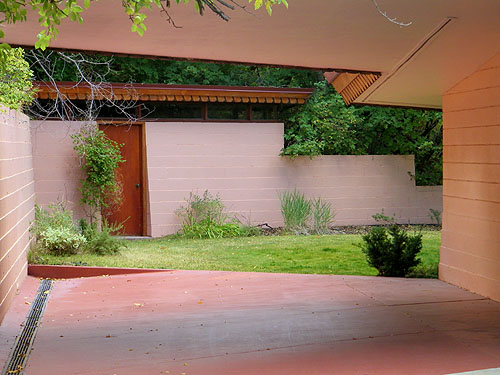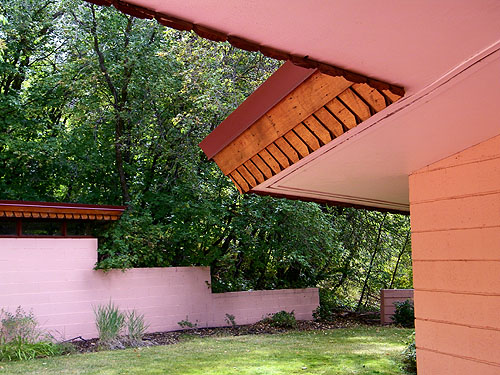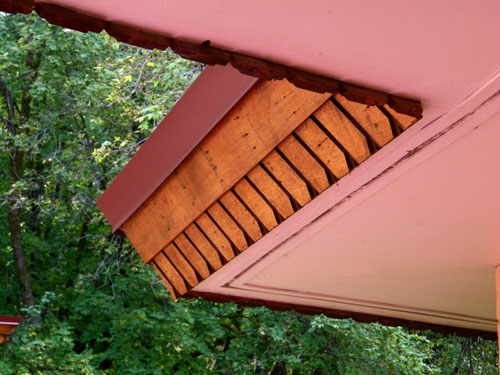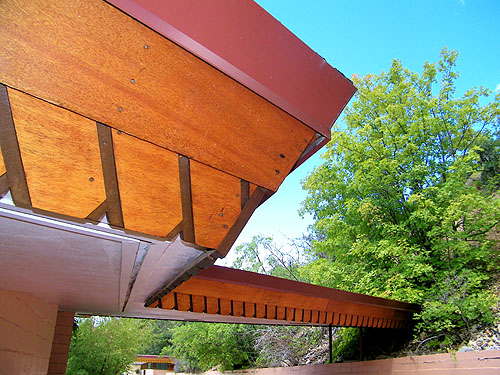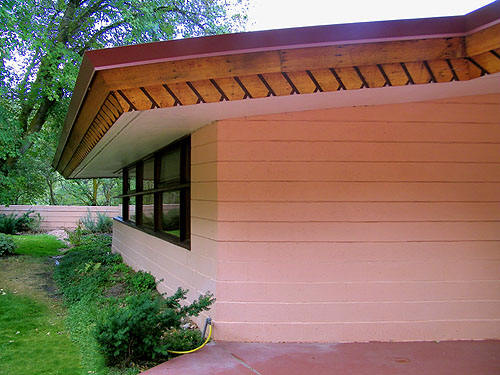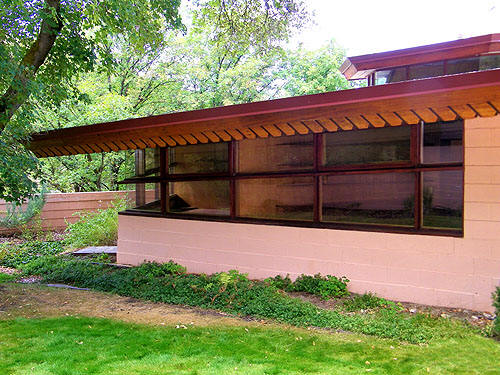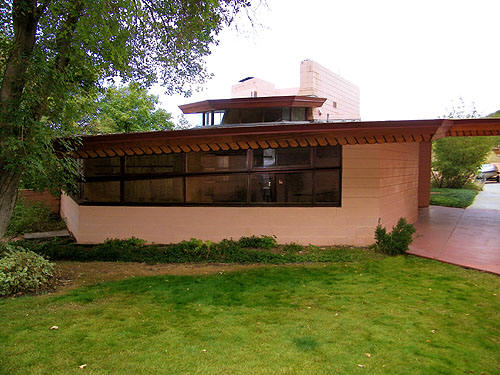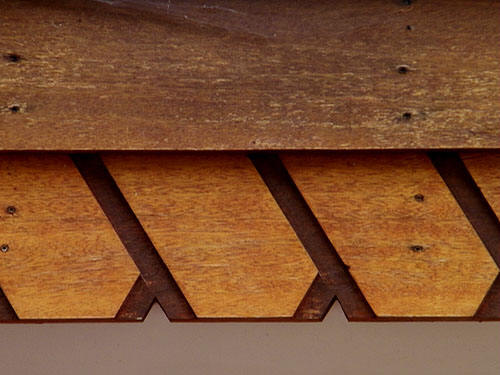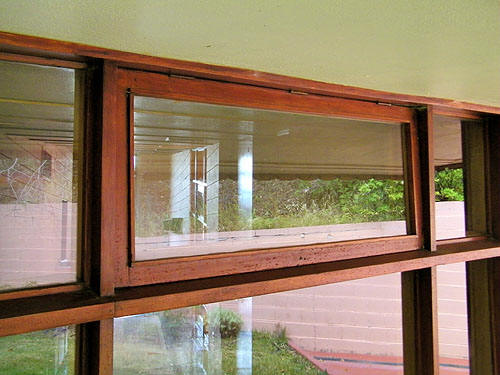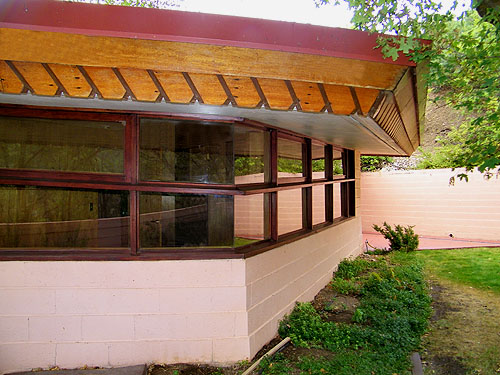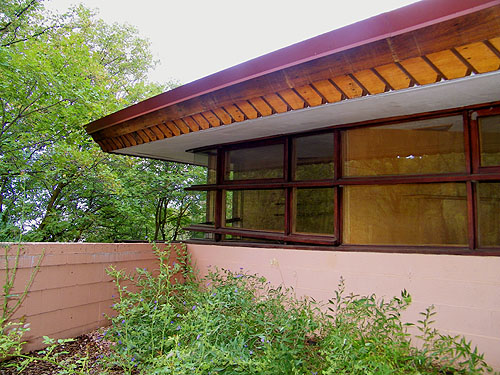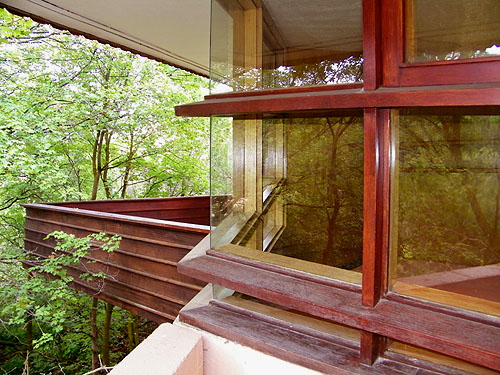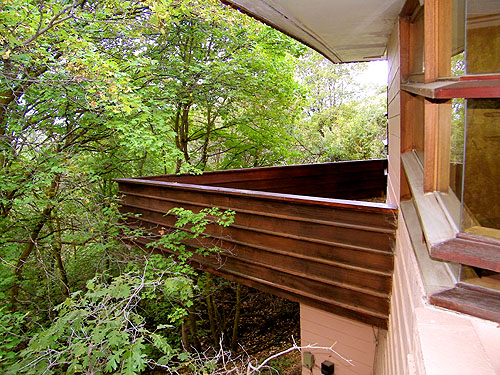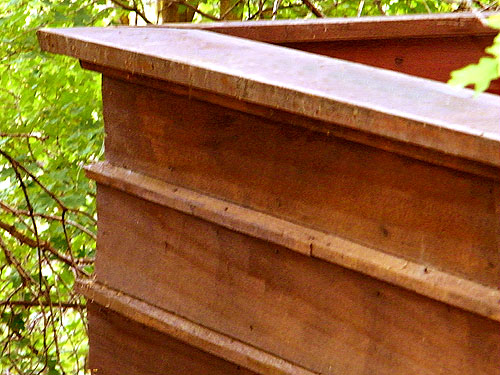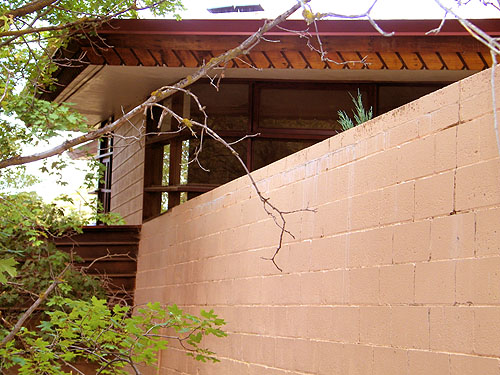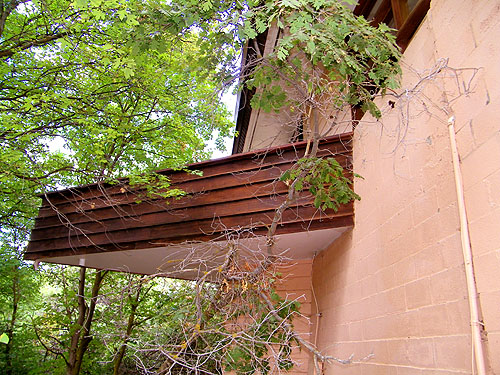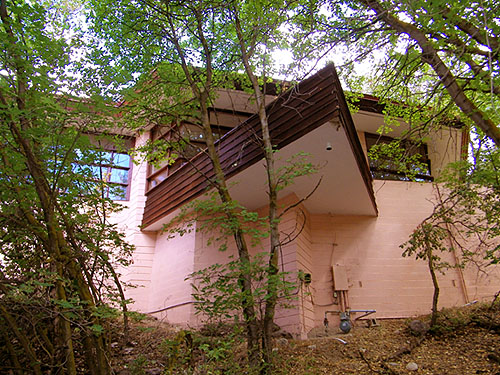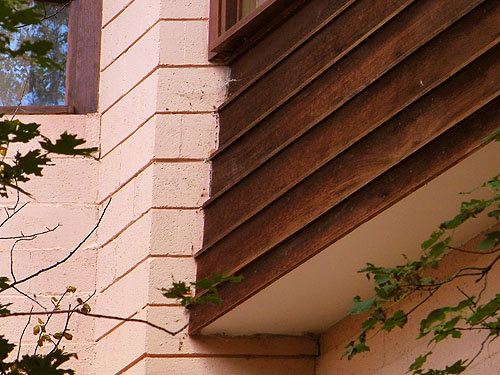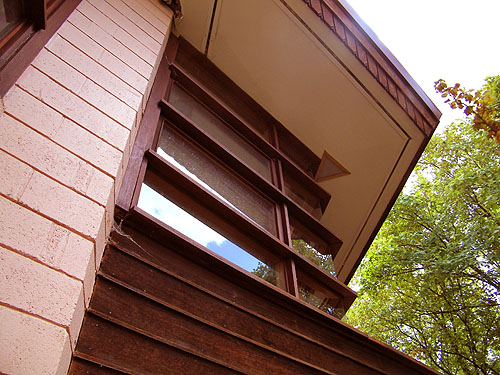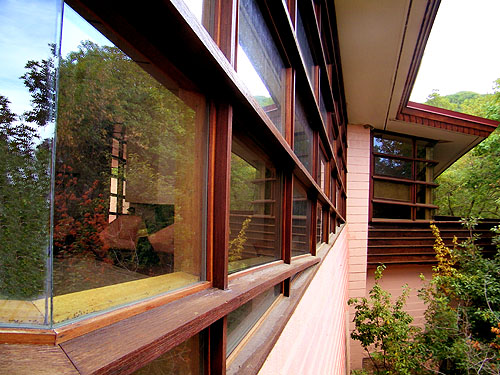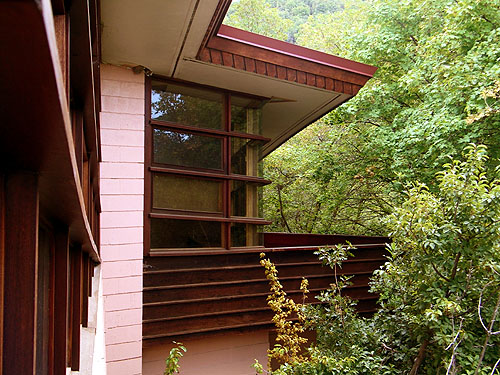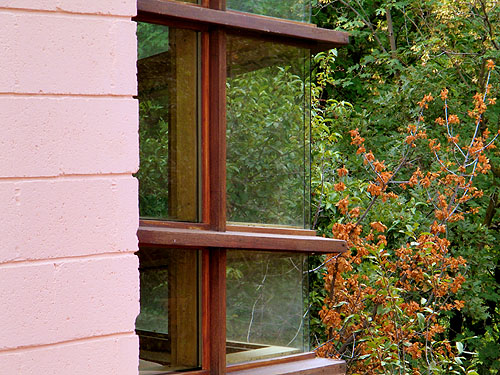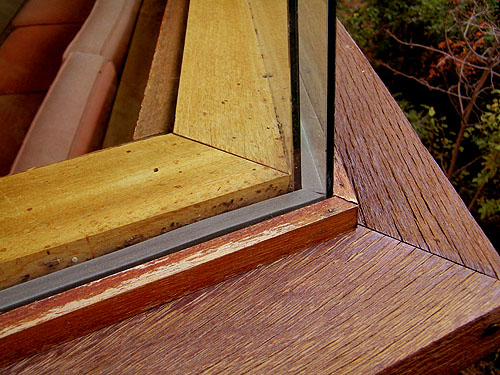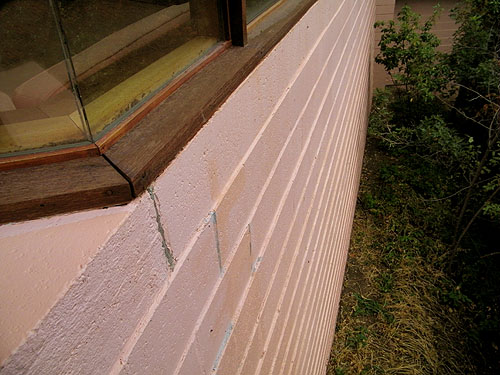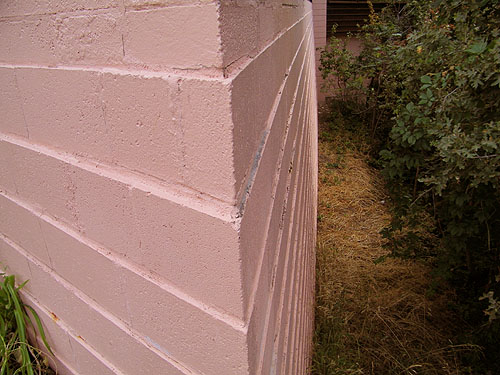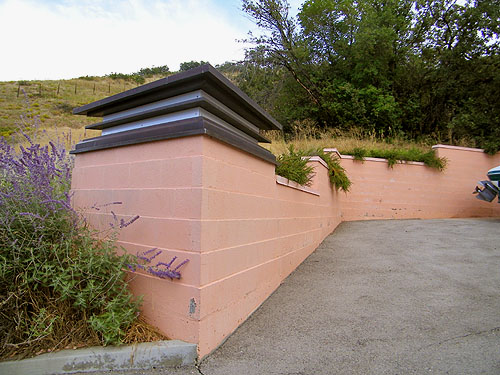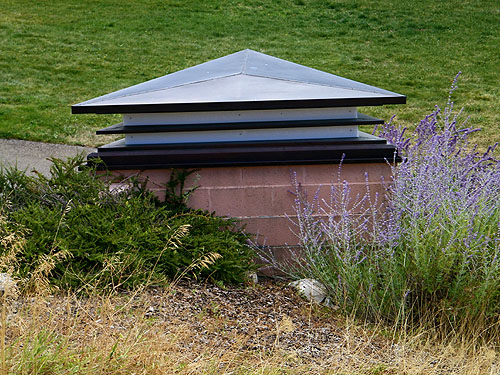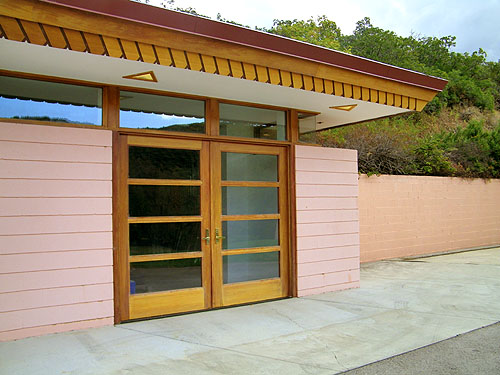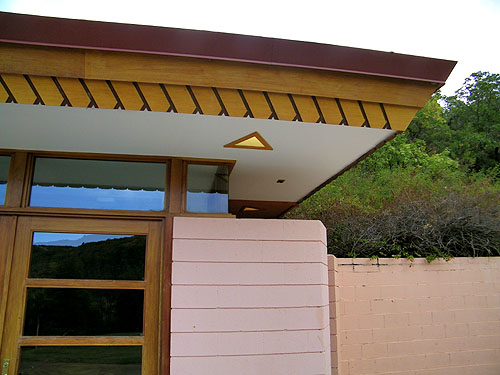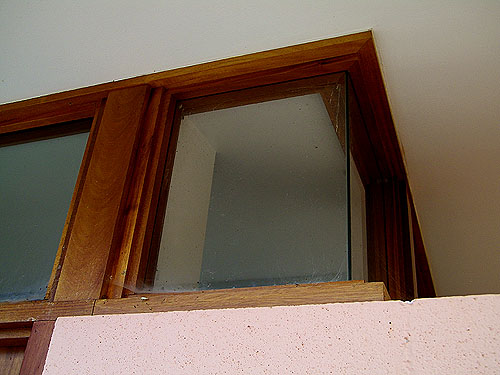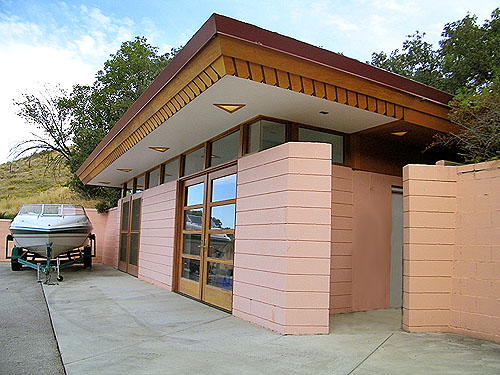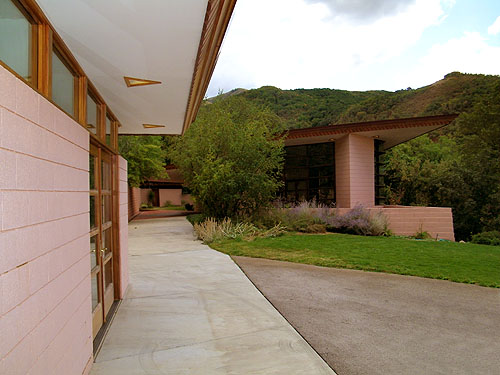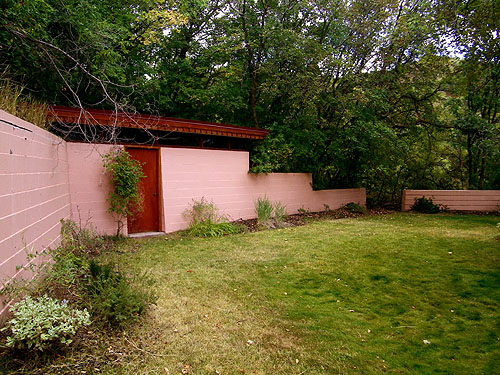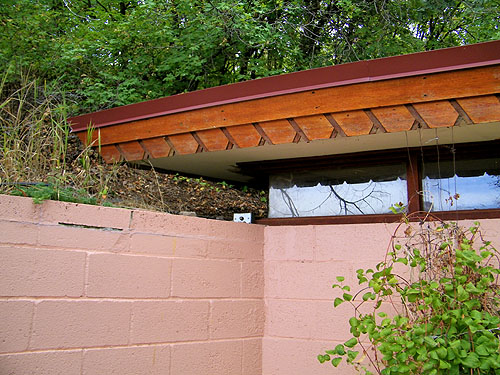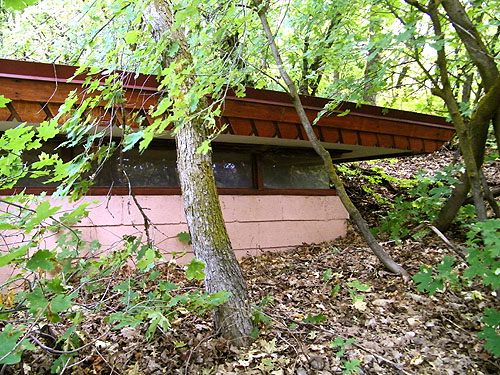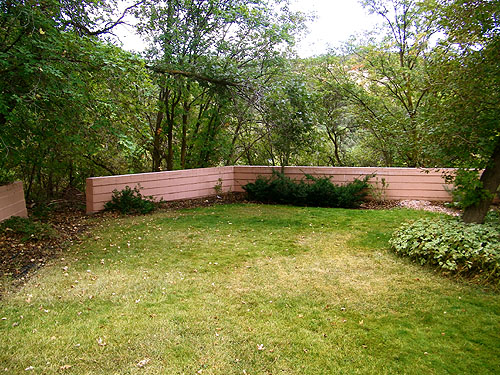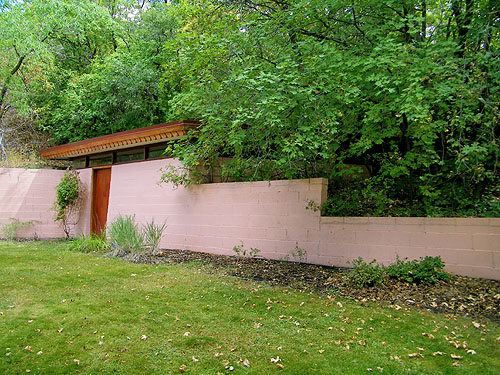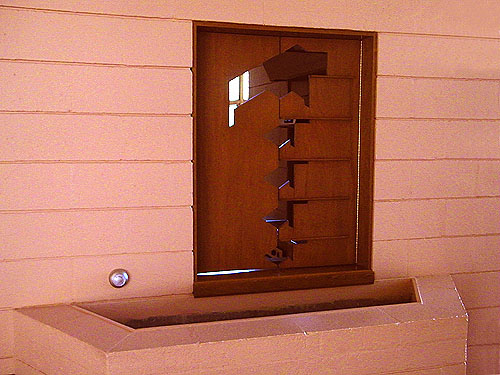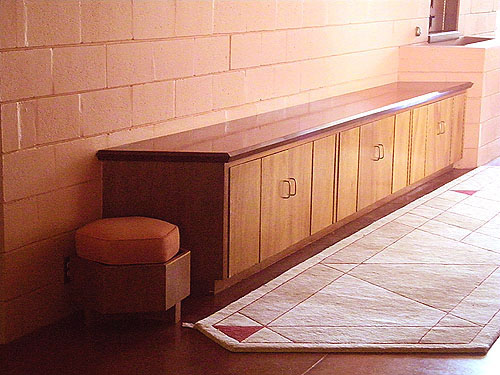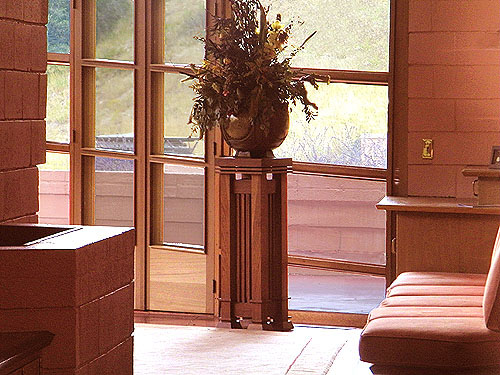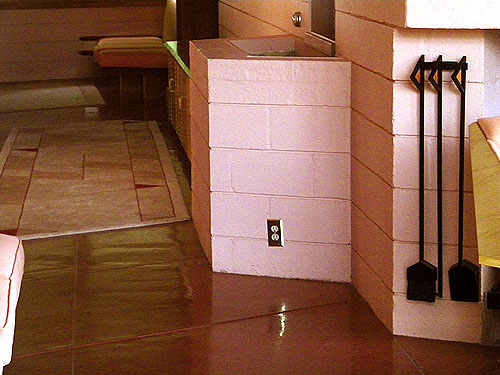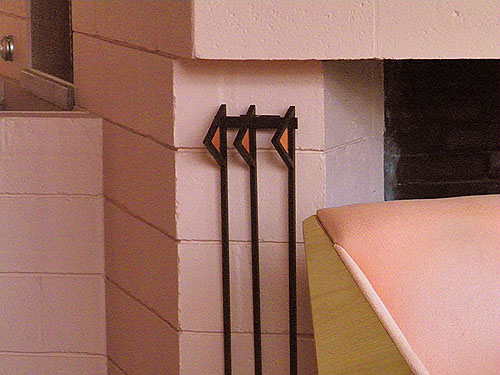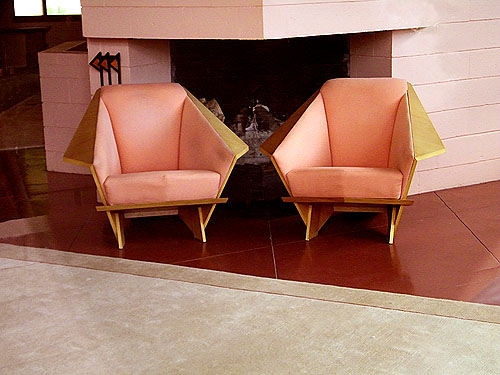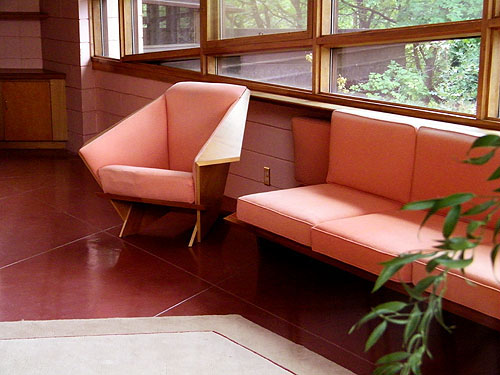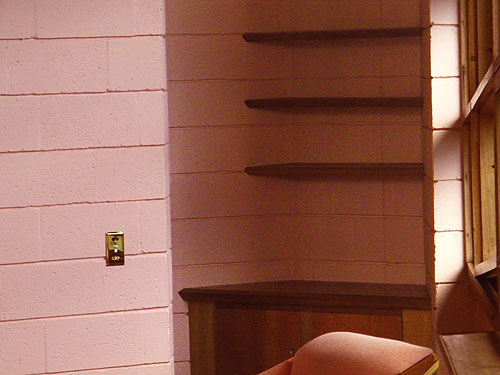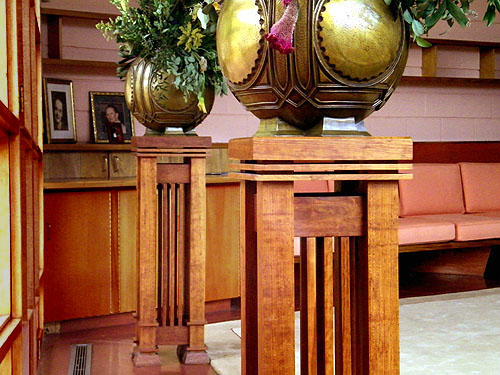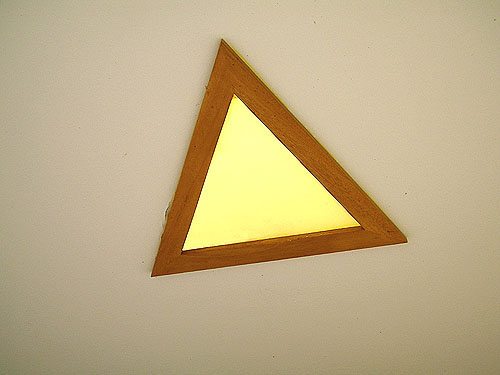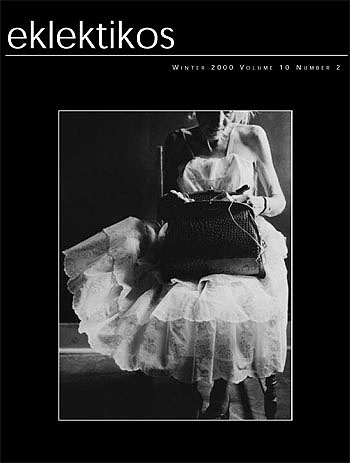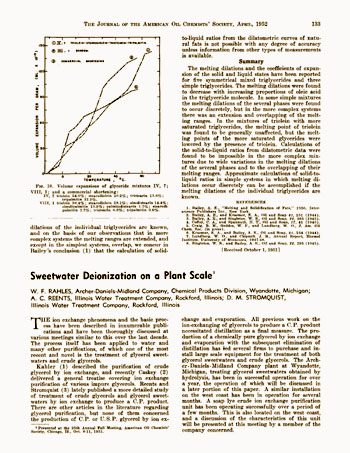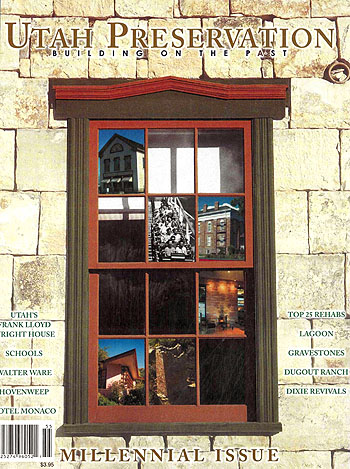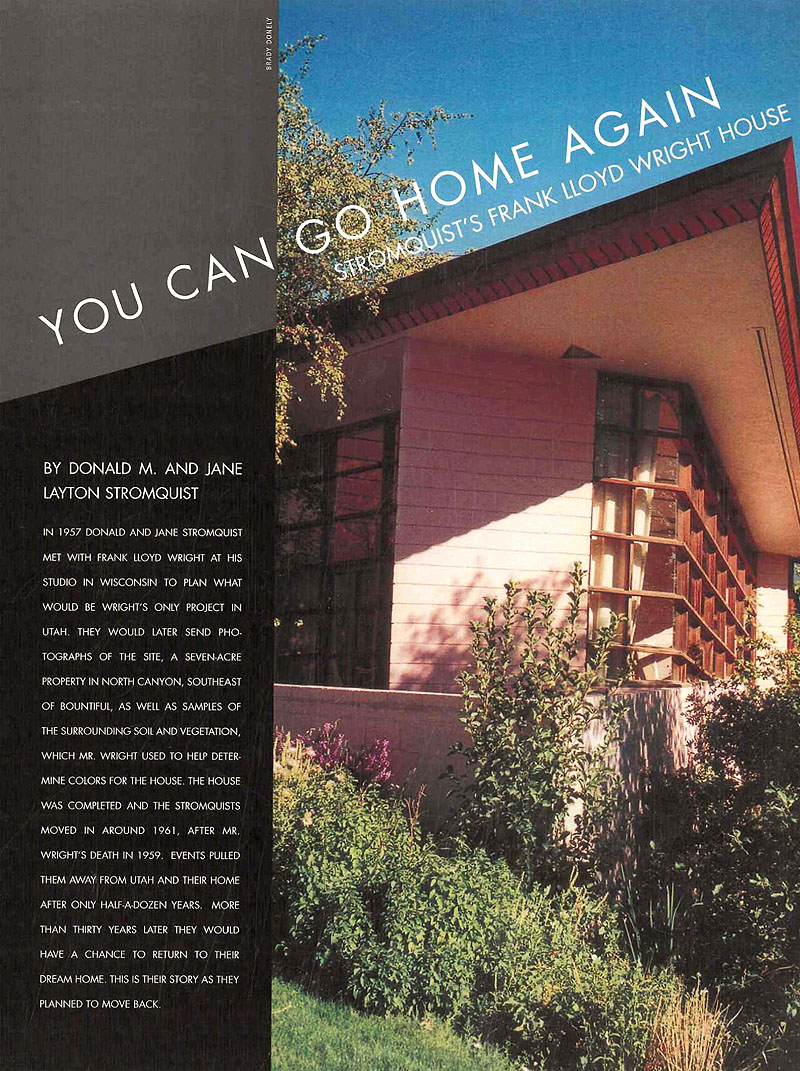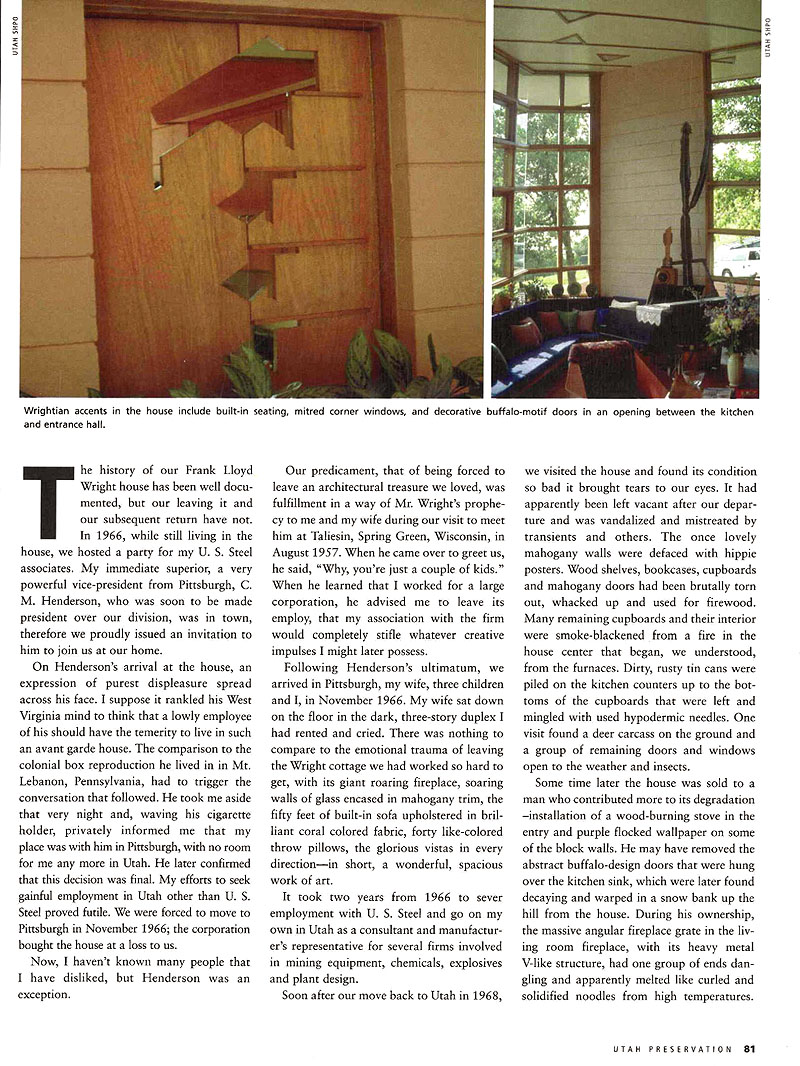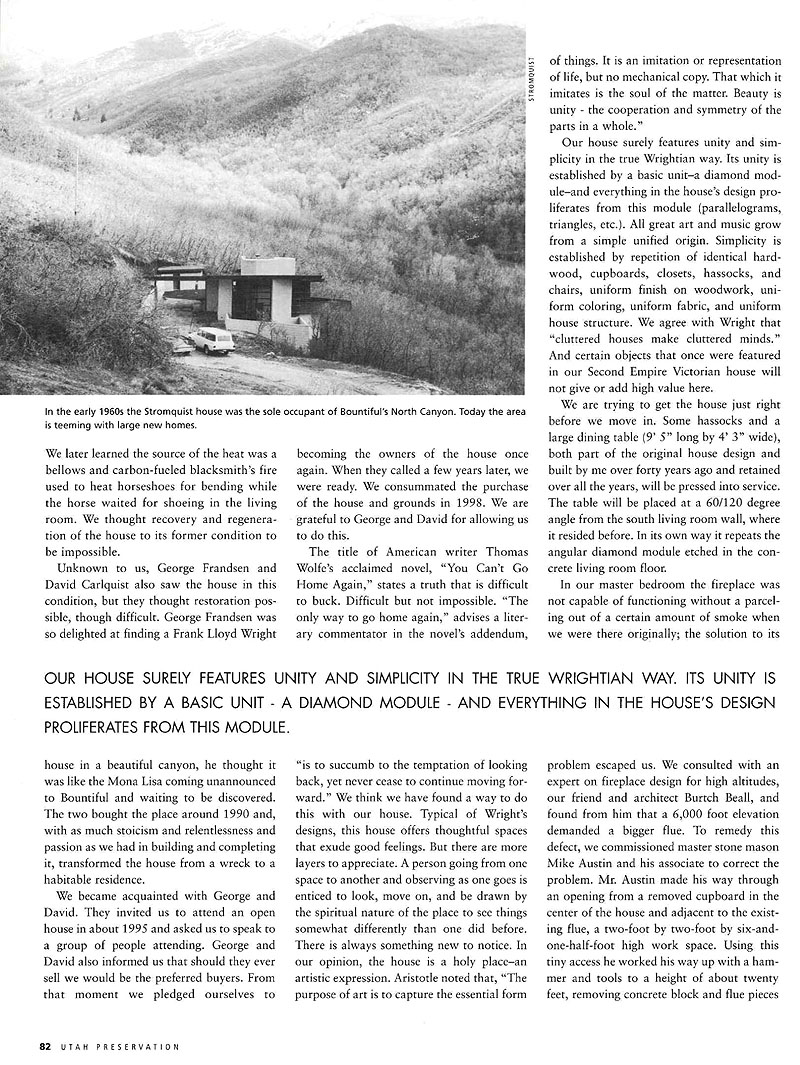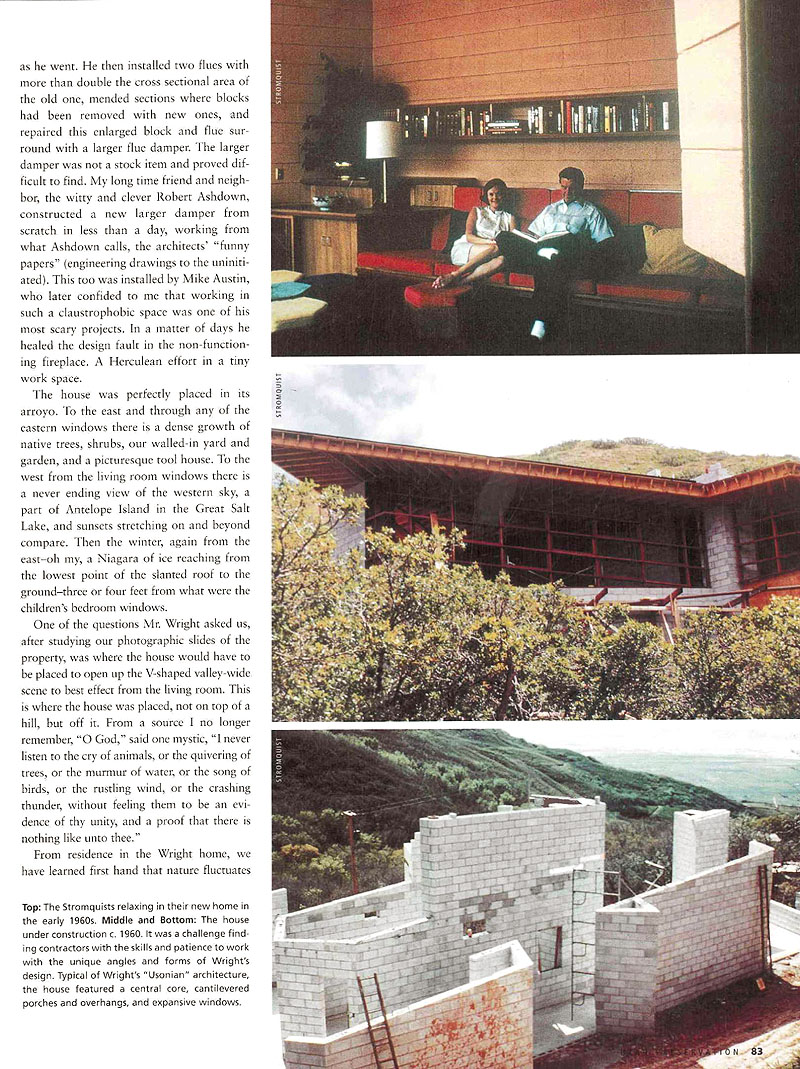
SUPPORT
THE WRIGHT LIBRARYPROCEEDS FROM EVERY SALE GOES TO SUPPORT THE WRIGHT LIBRARY.
CLICK TO ORDER.
WE PROUDLY SUPPORT THE FRANK LLOYD WRIGHT BUILDING CONSERVANCY
WE PROUDLY SUPPORT FALLINGWATER
AND THE WESTERN PENNSYLVANIA CONSERVANCY
DONALD M. & JANE STROMQUIST RESIDENCE (1958 - S.429) INTRODUCTION FLOOR PLAN PRESENTATION DRAWINGS 1958 INTERIOR 2004 EXTERIOR & INTERIOR 2009 REPRODUCTIONS
EKLEKIKOS JOURNAL AMERICAN OIL UTAH PRESERVATION ADDITIONAL WRIGHT STUDIESDate: 1950 Title: Proceedings, American Society of Sugar Beet Technology 1950 (Published by the American Society of Sugar Beet Technologists)
Author: Stromquist, Donald M.
Description: "Ion Exchange Behavior on Two-Boiling System at Layton Sugar Company" Report on Donald Stromquist's work in Layton, Utah. Includes three illustrations. (Digital and printed version)
Size: 8.5 x 11
Pages: Pp 549-553
S#: 0831.21.0310
Date: 1994
Title: Don M. Stromquist Residence, Bountiful, Utah, 1994 (1958 - S.429).
Description: View of the Stromquist Residence from the Northeast. From the peak over the living room and terrace, the roof slants down toward the back of the home. The slant of the Living Room windows match the slope of the roof, The triangle pier on the right of the glass wall, mirrors the triangle to the right of the Entryway. The basic materials are glass, concrete block and mahogany paneling and trim. Wright specified concrete blocks, raked only the horizontal joints, leaving the vertical joints flush with the face of the brick adding to the horizontal impression. Hand Written on verso: “Frank Lloyd Wright Architect. Bountiful, Utah Home.” Stamped on verso: “Aug 94.” Acquired from the The Salt Lake Tribune.
Size: Original 4 x 6 B&W photograph.
ST#: 1994.144.0223Date: 1994
Title: Don M. Stromquist Residence, Bountiful, Utah, 1994 (1958 - S.429).
Description: View of the Stromquist Residence from the Northeast. From the peak over the living room and terrace, the roof slants down toward the back of the home. The slant of the Living Room windows match the slope of the roof, The triangle pier on the right of the glass wall, mirrors the triangle to the right of the Entryway. The basic materials are glass, concrete block and mahogany paneling and trim. Wright specified concrete blocks, raked only the horizontal joints, leaving the vertical joints flush with the face of the brick adding to the horizontal impression. Hand Written on verso: “Frank Lloyd Wright Architect. Bountiful, Utah Home.” Stamped on verso: “Aug 94.” Acquired from the The Salt Lake Tribune.
Size: Original 4 x 6 B&W photograph.
ST#: 1994.145.0223Date: 2004
Title: Don M. Stromquist Residence, Bountiful, Utah, 2004 (1958 - S.429).
Description: Set of 36 Interior photographs of the Don M. Stromquist Residence. The Stromquist home is the only structure designed by Wright in the state of Utah. As you approach the home from the street below, the roof cantilevers skyward over the living room and terrace. The living room has two large walls of windows, one floor to ceiling. From the peak over the living room, the roof slants down toward the back of the home. Wright designed these windows to match the slope of the roof. The slope of the windows is not immediately evident, but becomes apparent as your eye follows... Continue...
Size: Set of 36 high res 10 X 6 digital images.
ST#: 2004.97.0310 (1-36)
See Additional Phgoitographs...
See Additional Phgoitographs...Date: 2009
Title: Donald M. And Jane Stromquist Residence, Bountiful, Utah, 2009 (1958 - S.429).
Description: Set of 65 exterior and 10 interior photographs of the Stromquist Residence. Donald Martin Stromquist (8/4/1924 - 8/27/2009) was born in Rockford, Illinois on August 4, 1924. His parents were Swedish immigrants. His first contact with Wright was as a boy in Illinois when he had an opportunity to hear Mr. Wright speak. Mr. Wright's impact on Donald as a boy, is unmistakable. He graduated from Marquette University with a degree in Chemical Engineering. After serving in World War II, he worked for the Illinois Water Treatment Company, where he created several water purification patents. In 1947 he engineered and coordinated the installation of a water treatment system at the Layton Sugar Factory in Layton, just north of Bountiful, Utah. He continued working with this client... Continue...
Size: Set of 65 exterior and 10 interior 23 X 15 high res digital images.
ST#: 2009.60.0310 (1-75)
See Additional Phgoitographs...
See Additional Phgoitographs...STROMQUIST RESIDENCE INTRODUCTION (1958 - S.429)
Donald Martin Stromquist (8/4/1924 - 8/27/2009) was born in Rockford, Illinois on August 4, 1924. His parents were Swedish immigrants. His first contact with Wright was as a boy in Illinois when he had an opportunity to hear Mr. Wright speak. Mr. Wright's impact on Donald as a boy, is unmistakable. He graduated from Marquette University with a degree in Chemical Engineering. After serving in World War II, he worked for the Illinois Water Treatment Company, where he created several water purification patents. In 1947 he engineered and coordinated the installation of a water treatment system at the Layton Sugar Factory in Layton, just north of Bountiful, Utah. He continued working with this client in 1948 and 1949, and the following year wrote and published an article about the process. In 1951 he co-authored another article about his work with the Illinois Water Treatment Company, Rockford, Illinois. It was presented at the 25th Annual Meeting of the American Oil Chemists, and published in 1952. It was during his time in Layton, Utah, that he met Jane Layton, a descendant of the original settlers. Donald and Jane were married in Layton, on January 31, 1953.
The Stromquists purchased a remote seven acre parcel of land in a canyon high above the Great Salt Lake. So remote it lacked power and water, but perfect for someone with Donald's engineering skills. They contacted Wright about designing a home and in August 1957 met with him at Taliesin in Spring Green to review the initial drawings. Upon greeting them Wright exclaimed "Why you're just a couple of kids" (Utah). They loved the concept but were concerned about cost. Wright made changes and sent new plans on March 20, 1959 (Wright 53-59 p 545). In 1960, a year following Wright's death, Taliesin Architects finished the working drawings, following Wright's second plan, but adding a study.
Construction finally began in 1961 (WW p101). Stromquist's talents and abilities allowed him to complete the furnishings and built-ins. Cornelia Brierly worked with Mrs. Stromquiest "selecting appealing fabrics for the home" (Tales p 104). "Crystalwood" was completed in 1963 (Storrer p 461).
In November 1966, after just a few years in their Wright home, the Stromquists were transferred to Pittsburgh. Jane sat down on the floor in their Pittsburgh duplex and cried (Utah). As agreed, their employer purchased their home. It was put on the market, but due to the remoteness, there were no buyers. It was unoccupied and neglects. Transients burned the Wright designed furniture Donald had painstakingly built. Then the doors and built-ins.
It took two years for Donald to arrange work as a rep and consultant and in 1968 moved back to Utah. They visited their old home and were devastated. In their estimate their Wright home was beyond repair. Tears welled up in their eyes (Utah).
A buyer was found, but lacked any appreciation for Wright's design, let alone any Wright details. The home was abused and continued to deteriorate. "It fell into the unworthy hands of a man who kept horses in the living room" (Tales p 104).
They threw themselves into another project, the four-story William Culmer Victorian mansion in Salt Lake City. For the next 18 years they painstakingly restored the mansion. They discovered elaborate murals, by Salt Lake City painter Henry Culmer, hidden under layers of wallpaper. It took Dale Jolley 14 years to fully restore them. On April 30, 2000, Bob Vila highlighted their work on his weekly television program..
Meanwhile, rescue was on the horizon for the original Stromquist Home. In 1989 after more than twenty years of neglect and abuse, the home was purchased with the intent on restoration. George Frandsen and David Carlquist contacted Taliesin. Restoration was to Wright's original specifications.Cornelia Brierly was approached and asked to work on the home again, and with the help of John deKoven Hill, new fabrics and carpets were selected and original furniture was rebuilt (Tales p 104).
The Stromquists had the opportunity to meet the new owners and in 1995 were invited to speak at their open house. They were also told that if they ever were to sell the home, the Stromquists would be at he top of their list.
The Stromquist home is the only structure designed by Wright in the state of Utah. As you approach the home from the street below, the roof cantilevers skyward over the living room and terrace. The living room has two large walls of windows, one floor to ceiling. From the peak over the living room, the roof slants down toward the back of the home. Wright designed these windows to match the slope of the roof. The slope of the windows is not immediately evident, but becomes apparent as your eye follows the slope at the floor. Wright used this window design in only one other home. The Archie Teater Studio. The doors are a work of art. They are set within a wall of glass. The top has the same slope as the roof. At first glance, the bottom gives the appearance to be at a slant also, but in reality is straight. The 2,700 square foot home has three bedrooms, two bathrooms, a work space (kitchen), living room, dining area, study, two fireplaces, one large centrally located in the living room, and two terraces. It is designed on a diamond grid consisting of 60 and 120 degree angles. The basic materials are glass, concrete block and mahogany. There are many classic Wright details. Originally designed in stone, the Stromquists felt it would be to costly (Masterworks p268). Wright replaced stone with concrete block and raked only the horizontal joints, leaving the vertical joints flush with the face of the brick. Wright also changed the layout of the floor plan, and sent new plans on March 20, 1959 (Wright p 544). In 1960, a year following Wright's death, Taliesin Architects finished the working drawings, following Wright's second plan, but adding a study. The seating, lighting, desks, cabinets and shelves are built-in. The kitchen has a perforated decorative shutter that opens toward the entry. There are mitered glass corner windows. Clerestory windows provide natural lighting to the bathrooms. The master bedroom has a fireplace and French doors that lead to a secluded terrace (balcony). The seven acre parcel of land was expanded to ten acres, and is in a canyon at 6,000 feet, high above the Great Salt Lake. There is a separate garage/office/laboratory, a shed and barn.
After ten years of ownership, including five years refurbishing the home, George and David contacted the Stromquists about purchasing the home. In 1998, the sale was completed. Plans were made for moving back in, their mansion was put on the market. The original dining room table and some of the original hassocks, built by Donald over forty years earlier, were "pressed into service" again. The master bedroom fireplace that never functioned, was repaired. (Utah).
Sadly Jane never realized her dream of moving back into her dream house. She passed away in November 1999. Donald was 75. He continued with their plans and was able to move in 2000 and live in his Wright house again for a few more years. His health finally required him to move out. Donald passed away on August 27, 2009, just after his 85th birthday.
"Whenever I see a Wright home or a Wright photo or a Wright building, it always comes to me with great intensity that Wright has mirrored Plato's ideal world. I can't think of anything that I think would be closer. It has to do with thought, a whole idealistic way of life. It has to do with all the things that are the best in us." Jane Stromquist. (Homearama)
Text by Douglas M. Steiner, Copyright September 2009.STROMQUIST FLOOR PLAN (1958) Floor plan illustrated by Douglas M. Steiner, copyright 2009. STROMQUIST PRESENTATION DRAWINGS (1958)
Original drawing of the Stromquist Residence. Courtesy of the Frank Lloyd Wright Foundation. Detail from the original Stromquist Residence drawing. INTERIOR PHOTOGRAPHS 2004
The Stromquist home is the only structure designed by Wright in the state of Utah. As you approach the home from the street below, the roof cantilevers skyward over the living room and terrace. The living room has two large walls of windows, one floor to ceiling. From the peak over the living room, the roof slants down toward the back of the home. Wright designed these windows to match the slope of the roof. The slope of the windows is not immediately evident, but becomes apparent as your eye follows the slope at the floor. Wright used this window design in only one other home. The Archie Teater Studio. The doors are a work of art. They are set within a wall of glass. The top has the same slope as the roof. At first glance, the bottom gives the appearance to be at a slant also, but in reality is straight. The 2,700 square foot home has three bedrooms, two bathrooms, a work space (kitchen), living room, dining area, study, two fireplaces, one large centrally located in the living room, and two terraces. It is designed on a diamond grid consisting of 60 and 120 degree angles. The basic materials are glass, concrete block and mahogany. There are many classic Wright details. Originally designed in stone, the Stromquists felt it would be to costly. Wright replaced stone with concrete block and raked only the horizontal joints, leaving the vertical joints flush with the face of the brick. The seating, lighting, desks, cabinets and shelves are built-in. The kitchen has a perforated decorative shutter that opens toward the entry. There are mitered glass corner windows. Clerestory windows provide natural lighting to the bathrooms. The master bedroom has a fireplace and French doors that lead to a secluded terrace (balcony). The original dining room table and some of the original hassocks, built by Donald over forty years earlier, were "pressed into service" again. The master bedroom fireplace that never functioned, was repaired. Set of 36 Interior photographs of the Don M. Stromquist Residence by Brady Donley, May 2004.
1) Don M. Stromquist Residence Interior, Bountiful, Utah, 2004 (1958 - S.429). View from the entry hall looking West at the Living Room. The Dining area is to the far left. The ceiling slopes upward toward the diamond shaped pier and cantilevers outward, giving the appearance that it floats effortlessly past the windowed walls. (ST#2004.97.0310-1) 2) Don M. Stromquist Residence Interior, Bountiful, Utah, 2004 (1958 - S.429). Wright designed these windows to match the slope of the roof. The slope of the windows is not immediately evident, but becomes apparent as your eye follows the slope just above the built-in seating. There are mitered glass corner windows. (ST#2004.97.0310-2) 3) Don M. Stromquist Residence Interior, Bountiful, Utah, 2004 (1958 - S.429). The Wright designed "Origami Chair" fits naturally in the Living Room. Some of the original hassocks, built by Donald over forty years earlier, were "pressed into service" again. The home was designed on a diamond grid consisting of 60 and 120 degree angles which were also inscribed in the floor. (ST#2004.97.0310-3)
4) Don M. Stromquist Residence Interior, Bountiful, Utah, 2004 (1958 - S.429). Living Room viewed from the North. Wright designed these windows to match the slope of the roof. The slope of the windows become apparent as your eye moves down just above the built-in seating. The windows on the right have mitered glass corners. (ST#2004.97.0310-4) 5) Don M. Stromquist Residence Interior, Bountiful, Utah, 2004 (1958 - S.429). The original Wright designed dining room table built by Donald over forty years earlier, was "pressed into service" again in 2000 when he had the opportunity to purchase and move back into his home. The table and chairs are designed to utilize the same angles used throughout the home. (ST#2004.97.0310-5) 6) Don M. Stromquist Residence Interior, Bountiful, Utah, 2004 (1958 - S.429). The Wright designed "Origami Chair" fits naturally in the Living Room. (ST#2004.97.0310-6)
7) Don M. Stromquist Residence Interior, Bountiful, Utah, 2004 (1958 - S.429). Living Room viewed from the Southwest. The furniture was designed by Wright. Seating, ceiling lights, cabinets and shelves are built-in. The centrally located fireplace is on the right. (ST#2004.97.0310-7) 8) Don M. Stromquist Residence Interior, Bountiful, Utah, 2004 (1958 - S.429). The Wright designed "Origami Chair" fits naturally in the Living Room. The hassocks and coffee table were also designed by Wright. (ST#2004.97.0310-8) 9) Don M. Stromquist Residence Interior, Bountiful, Utah, 2004 (1958 - S.429). Wright designed the cabinets, seating, and shelves are built-in as well as the "Origami Chairs", hassock and coffee table. (ST#2004.97.0310-9) 10) Don M. Stromquist Residence Interior, Bountiful, Utah, 2004 (1958 - S.429). The centrally located fireplace is on the right and steps back and down. The home was designed on a diamond grid consisting of 60 and 120 degree angles which were also inscribed in the floor. (ST#2004.97.0310-10) 11) Don M. Stromquist Residence Interior, Bountiful, Utah, 2004 (1958 - S.429). Living Room viewed from the South. The original Wright designed dining room table built by Donald over forty years earlier, was "pressed into service" again in 2000. The concrete block walls were raked only on the horizontal joints, leaving the vertical joints flush with the face of the brick. (ST#2004.97.0310-11) 12) Don M. Stromquist Residence Interior, Bountiful, Utah, 2004 (1958 - S.429). The doors are a work of art. They are set within a wall of glass. The top has the same slope as the roof. (ST#2004.97.0310-12) 13) Don M. Stromquist Residence Interior, Bountiful, Utah, 2004 (1958 - S.429). The original Wright designed dining room table built by Donald over forty years earlier, was "pressed into service" again in 2000. Reproduction of Wright designed copper weed holder is sitting on the table. (ST#2004.97.0310-13) EXTERIOR STROMQUIST PHOTOGRAPHS 2009 EXTERIOR GARAGE SHED INTERIOR
Donald M. And Jane Stromquist Residence, Bountiful, Utah, 2009 (1958 - S.429). Set of 65 exterior and 10 interior photographs of the Stromquist Residence. Donald Martin Stromquist (8/4/1924 - 8/27/2009) was born in Rockford, Illinois on August 4, 1924. His parents were Swedish immigrants. His first contact with Wright was as a boy in Illinois when he had an opportunity to hear Mr. Wright speak. Mr. Wright's impact on Donald as a boy, is unmistakable. He graduated from Marquette University with a degree in Chemical Engineering. After serving in World War II, he worked for the Illinois Water Treatment Company, where he created several water purification patents. In 1947 he engineered and coordinated the installation of a water treatment system at the Layton Sugar Factory in Layton, just north of Bountiful, Utah. He continued working with this client in 1948 and 1949, and the following year wrote and published an article about the process. In 1951 he co-authored another article about his work with the Illinois Water Treatment Company, Rockford, Illinois. It was presented at the 25th Annual Meeting of the American Oil Chemists, and published in 1952. It was during his time in Layton, Utah, that he met Jane Layton, a descendant of the original settlers. Donald and Jane were married in Layton, on January 31, 1953.
The Stromquists purchased a remote seven acre parcel of land in a canyon high above the Great Salt Lake. So remote it lacked power and water, but perfect for someone with Donald's engineering skills. They contacted Wright about designing a home and in August 1957 met with him at Taliesin in Spring Green to review the initial drawings. Upon greeting them Wright exclaimed "Why you're just a couple of kids" (Utah). They loved the concept but were concerned about cost. Wright made changes and sent new plans on March 20, 1959 (Wright53-59 p 545). In 1960, a year following Wright's death, Taliesin Architects finished the working drawings, following Wright's second plan, but adding a study.
Construction finally began in 1961 (WW p101). Stromquist's talents and abilities allowed him to complete the furnishings and built-ins. Cornelia Brierly worked with Mrs. Stromquiest "selecting appealing fabrics for the home" (Tales p 104). "Crystalwood" was completed in 1963 (Storrer p 461).
In November 1966, after just a few years in their Wright home, the Stromquists were transferred to Pittsburgh. Jane sat down on the floor in their Pittsburgh duplex and cried (Utah). As agreed, their employer purchased their home. It was put on the market, but due to the remoteness, there were no buyers. It was unoccupied and neglects. Transients burned the Wright designed furniture Donald had painstakingly built. Then the doors and built-ins.
It took two years for Donald to arrange work as a rep and consultant and in 1968 moved back to Utah. They visited their old home and were devastated. In their estimate their Wright home was beyond repair. Tears welled up in their eyes (Utah).
A buyer was found, but lacked any appreciation for Wright's design, let alone any Wright details. The home was abused and continued to deteriorate. "It fell into the unworthy hands of a man who kept horses in the living room" (Tales p 104).
They threw themselves into another project, the four-story William Culmer Victorian mansion in Salt Lake City. For the next 18 years they painstakingly restored the mansion. They discovered elaborate murals, by Salt Lake City painter Henry Culmer, hidden under layers of wallpaper. It took Dale Jolley 14 years to fully restore them. On April 30, 2000, Bob Vila highlighted their work on his weekly television program.
Meanwhile, rescue was on the horizon for the original Stromquist Home. In 1989 after more than twenty years of neglect and abuse, the home was purchased with the intent on restoration. George Frandsen and David Carlquist contacted Taliesin. Restoration was to Wright's original specifications. Cornelia Brierly was approached and asked to work on thehome again, and with the help of John deKoven Hill, new fabrics and carpets were selected and original furniture was rebuilt (Tales p 104).
The Stromquists had the opportunity to meet the new owners and in 1995 were invited to speak at their open house. They were also told that if they ever were to sell the home, the Stromquists would be at he top of their list.
The Stromquist home is the only structure designed by Wright in the state of Utah. As you approach the home from the street below, the roof cantilevers skyward over the living room and terrace. The living room has two large walls of windows, one floor to ceiling. From the peak over the living room, the roof slants down toward the back of the home. Wright designed these windows to match the slope of the roof. The slope of the windows is not immediately evident, but becomes apparent as your eye follows the slope at the floor. Wright used this window design in only one other home. The Archie Teater Studio. The doors are a work of art. They are set within a wall of glass. The top has the same slope as the roof. At first glance, the bottom gives the appearance to be at a slant also, but in reality is straight. The 2,700 square foot home has three bedrooms, two bathrooms, a work space (kitchen), living room, dining area, study, two fireplaces, one large centrally located in the living room, and two terraces. It is designed on a diamond grid consisting of 60 and 120 degree angles. The basic materials are glass, concrete block and mahogany. There are many classic Wright details. Originally designed in stone, the Stromquists felt it would be to costly (Masterworks p.268). Wright replaced stone with concrete block and raked only the horizontal joints, leaving the vertical joints flush with the face of the brick. Wright also changed the layout of the floor plan, and sent new plans on March 20, 1959 (Wright p 544). In 1960, a year following Wright's death, Taliesin Architects finished the working drawings, following Wright's second plan, but adding a study. The seating, lighting, desks, cabinets and shelves are built-in. The kitchen has a perforated decorative shutter that opens toward the entry. There are mitered glass corner windows. Clerestory windows provide natural lighting to the bathrooms. The master bedroom has a fireplace and French doors that lead to a secluded terrace (balcony). The seven acre parcel of land was expanded to ten acres, and is in a canyon at 6,000 feet, high above the Great Salt Lake. There is a separate garage/office/laboratory, a shed and barn.
After ten years of ownership, including five years refurbishing the home, George and David contacted the Stromquists about purchasing the home. In 1998, the sale was completed. Plans were made for moving back in, their mansion was put on the market. The original dining room table and some of the original hassocks, built by Donald over forty years earlier, were "pressed into service" again. The master bedroom fireplace that never functioned, was repaired. (Utah).
Sadly Jane never realized her dream of moving back into her dream house. She passed away in November 1999. Donald was 75. He continued with their plans and was able to move in 2000 and live in his Wright house again for a few more years. His health finally required him to move out. Donald passed away on August 27, 2009, just after his 85th birthday.
"Whenever I see a Wright home or a Wright photo or a Wright building, it always comes to me with great intensity that Wright has mirrored Plato's ideal world. I can't think of anything that I think would be closer. It has to do with thought, a whole idealistic way of life. It has to do with all the things that are the best in us." Jane Stromquist. (Homearama)
Photographed in September, 2009 during a visit to Utah by Douglas M. Steiner. Our intent is to record the details that create the totality of the design, creating a complete picture. Set of 65 exterior and 10 interior 23 X 15 high res digital images. Text by Douglas M. Steiner, Copyright September 2009.
STROMQUIST GARAGE 2009
The Lamp and Pedestal, Garage and the extension of the retaining wall were added by Donald Stromquist when he moved back into the home. The additions followed the same design concepts found in the home. The rows of concrete block in the retaining wall are slightly inset, slanting the wall away from the home. The Garage is inset into the hillside, and retains the same details as the rest of the home. The windows match the celestory windows in the home and shed. The celestory windows allow natural light within the Garage and include mitered glass corners. The fascia matches the home. The Garage doors also match, but are not slanted.
48) Don M. Stromquist Residence Exterior, Bountiful, Utah, 2009 (1958 - S.429). The Lamp and Pedestal, Garage and extended retaining wall viewed from the West. These were added by Donald Stromquist when he moved back into the home. (ST#2009.60.0310-48) 49) Don M. Stromquist Residence Exterior, Bountiful, Utah, 2009 (1958 - S.429). The pedestal and retaining wall retain the same features of the home. The rows of concrete block in the retaining wall are slightly inset, slanting the wall away from the home. The horizontal lines are raked, adding to the horizontal feel. (ST#2009.60.0310-49) 50) Don M. Stromquist Residence Exterior, Bountiful, Utah, 2009 (1958 - S.429). The Lamp and Pedestal viewed from the Northwest. (ST#2009.60.0310-50) 51) Don M. Stromquist Residence Exterior, Bountiful, Utah, 2009 (1958 - S.429). The Garage viewed from the West. The Garage is inset into the hillside, and retains the same details as the rest of the home. The windows match the celestory windows in the home and shed. The fascia matches the home. The Garage doors also match, but are not slanted. (ST#2009.60.0310-51) 52) Don M. Stromquist Residence Exterior, Bountiful, Utah, 2009 (1958 - S.429). The Garage viewed from the West. The celestory windows allow natural light within the garage and include mitered glass corners. (ST#2009.60.0310-52) 53) Don M. Stromquist Residence Exterior, Bountiful, Utah, 2009 (1958 - S.429). Detail of the mitered glass corner. (ST#2009.60.0310-53)
54) Don M. Stromquist Residence Exterior, Bountiful, Utah, 2009 (1958 - S.429). The Garage viewed from the Southeast. The celestory windows allow natural light within the Garage and include mitered glass corners. The fascia matches the home. (ST#2009.60.0310-54)
55) Don M. Stromquist Residence Exterior, Bountiful, Utah, 2009 (1958 - S.429). The Garage viewed from the Northwest and shows the relationship to the home. (ST#2009.60.0310-55) STROMQUIST SHED 2009
The retaining wall and Shed were constructed at the same time as the home. The rows of concrete block in the retaining wall are slightly inset, slanting the wall away from the home. The Shed is inset into the hillside, but retains the same details as the rest of the home. The windows match the celestory windows in the home and create a row of windows that wrap all the way around, giving the impression that the roof is floating. The celestory windows allow natural light within the shed and include mitered glass corners. To the right of the shed, the retaining wall stair steps down to the base of the window line and encloses the back yard. The fascia matches the home.
56) Don M. Stromquist Residence Exterior, Bountiful, Utah, 2009 (1958 - S.429). The Drive viewed from the Northwest. The Shed is on the left in the background. The hidden Entrance is in the center under the roof covering the Carport. The Living Room is n the right. (ST#2009.60.0310-56) 57) Don M. Stromquist Residence Exterior, Bountiful, Utah, 2009 (1958 - S.429). The retaining wall and Shed were constructed at the same time as the home. The rows of concrete block in the retaining wall are slightly inset, slanting the wall away from the home. The Shed is in the center background. The hidden Entrance is on the right. It is as if Wright could envision these angles fitting together like a puzzle. (ST#2009.60.0310-57) 58) Don M. Stromquist Residence Exterior, Bountiful, Utah, 2009 (1958 - S.429). The Shed viewed from the Northwest. Wright set the Shed behind the retaining wall, inset into the hillside. Celestory windows allow natural light within the shed. The "slant" of the retaining wall becomes more apparent as it intersects the doorway. (ST#2009.60.0310-58) 59) Don M. Stromquist Residence Exterior, Bountiful, Utah, 2009 (1958 - S.429). The retaining wall stair steps down to the base of the window line and encloses the back yard. (ST#2009.60.0310-59) 60) Don M. Stromquist Residence Exterior, Bountiful, Utah, 2009 (1958 - S.429). The Shed is inset into the hillside, but retains the same details as the rest of the home. The windows match the celestory windows in the home and create a row of windows that wrap all the way around. The celestory windows allow natural light within the shed and include mitered glass corners. (ST#2009.60.0310-60) 61) Don M. Stromquist Residence Exterior, Bountiful, Utah, 2009 (1958 - S.429). The celestory windows allow natural light within the shed and include mitered glass corners. (ST#2009.60.0310-61)
62) Don M. Stromquist Residence Exterior, Bountiful, Utah, 2009 (1958 - S.429). The celestory windows allow natural light within the shed and include mitered glass corners. (ST#2009.60.0310-62)
63) Don M. Stromquist Residence Exterior, Bountiful, Utah, 2009 (1958 - S.429). The retaining wall stair steps down to the base of the window line, and enclose the back yard. (ST#2009.60.0310-63) 64) Don M. Stromquist Residence Exterior, Bountiful, Utah, 2009 (1958 - S.429). Viewed from the North, the retaining wall encloses the back yard. (ST#2009.60.0310-64) 65) Don M. Stromquist Residence Exterior, Bountiful, Utah, 2009 (1958 - S.429). The Shed viewed from the West. (ST#2009.60.0310-65) STROMQUIST INTERIOR 2009
There are few changes to the Stromquist house since the interior photographs in 2004. The house is for sale, has been for a number of years, and as with the sale the first time over forty years ago, there have been few lookers. But even after a number of years on the market, it has retained its quality and enchantment as a Wright house. Custom designed carpets adorn the Entryway and Living Room. Two reproductions of Wright designed Copper Urns are displayed on prairie styled pedestals in the Living Room, as well as custom fireplace tools. The original dining room table and chairs are in storage for safe keeping as well as some of the other furniture. But, an empty house is not a home. Not only are the details of life missing, so are its occupants. Donald and Jane Stromquist who had the foresight to hire Wright, and George Frandsen and David Carlquist who had the fortitude to rescue and restore the home.
66) Don M. Stromquist Residence Exterior, Bountiful, Utah, 2009 (1958 - S.429). Entry viewed from the Northwest. The buffalo design shutter opens to give a view of the Kitchen. The built-in planter is in foreground. (ST#2009.60.0310-66) 67) Don M. Stromquist Residence Exterior, Bountiful, Utah, 2009 (1958 - S.429). Built-in storage is to the left of the planter. The hassock was designed by Wright. (ST#2009.60.0310-67) 68) Don M. Stromquist Residence Exterior, Bountiful, Utah, 2009 (1958 - S.429). The Living Room viewed from the Entryway. Built-in Planter in the left, a reproduction of Wright's designed Copper Urn is setting on a prairie styled pedestal, built-in seating is on the right. (ST#2009.60.0310-68) 69) Don M. Stromquist Residence Exterior, Bountiful, Utah, 2009 (1958 - S.429). The Entryway viewed from the Northwest. The Living Room Fireplace is on the right and include custom fireplace tools. (ST#2009.60.0310-69) 70) Don M. Stromquist Residence Exterior, Bountiful, Utah, 2009 (1958 - S.429). Detail of the Living Room Fireplace and fireplace tools. (ST#2009.60.0310-70) 71) Don M. Stromquist Residence Exterior, Bountiful, Utah, 2009 (1958 - S.429). Living Room fireplace viewed from the Northwest. The Wright designed "Origami Chairs" fits naturally in the Living Room. (ST#2009.60.0310-71)
72) Don M. Stromquist Residence Exterior, Bountiful, Utah, 2009 (1958 - S.429). Living Room viewed from the Northwest. Built-in shelving in the hallway to the left, which leads the the Workspace. The Wright designed "Origami Chair" is in the center, built-in seating on the Southeast wall. The Master bedroom balcony can be seen in the background thorough the windows. (ST#2009.60.0310-72)
73) Don M. Stromquist Residence Exterior, Bountiful, Utah, 2009 (1958 - S.429). Built-in shelving is in the hallway which leads the the Workspace. (ST#2009.60.0310-73) 74) Don M. Stromquist Residence Exterior, Bountiful, Utah, 2009 (1958 - S.429). Living Room viewed from the Southwest. Two reproductions of Wright's designed Copper Urn are setting on matching prairie styled pedestals in the foreground, built-in storage is on the left, built-in seating is on the right. (ST#2009.60.0310-74) 75) Don M. Stromquist Residence Exterior, Bountiful, Utah, 2009 (1958 - S.429). Detail of the built-in recessed lighting used throughout the home. (ST#2009.60.0310-75) STROMQUIST REPRODUCTIONS
1) Don M. Stromquist Residence Interior, Bountiful, Utah, 2004 (1958 - S.429). Living Room viewed from the South. The original Wright designed dining room table built by Donald over forty years earlier, was "pressed into service" again in 2000. The concrete block walls were raked only on the horizontal joints, leaving the vertical joints flush with the face of the brick. Reproduction of Wright designed copper weed holder is sitting on the table. (ST#2004.97.0310-11) 2) Don M. Stromquist Residence Interior, Bountiful, Utah, 2004 (1958 - S.429). The original Wright designed dining room table built by Donald over forty years earlier, was "pressed into service" again in 2000. Reproduction of Wright designed copper weed holder is sitting on the table. (ST#2004.97.0310-13) 3) Don M. Stromquist Residence Exterior, Bountiful, Utah, 2009 (1958 - S.429). The Living Room viewed from the Entryway. Built-in Planter in the left, a reproduction of Wright's designed Copper Urn is setting on a prairie styled pedestal, built-in seating is on the right. (ST#2009.60.0310-68) 4) Don M. Stromquist Residence Exterior, Bountiful, Utah, 2009 (1958 - S.429). Living Room viewed from the Southwest. Two reproductions of Wright's designed Copper Urn are setting on matching prairie styled pedestals in the foreground, built-in storage is on the left, built-in seating is on the right. (ST#2009.60.0310-74) EKLETIKOS Date: 2000 Title: eklektikos - Winter 2000 (Published by the University of Utah, School of Medicine, Student Magazine)
Author: Thackeray, Elizabeth Merrill
Description: "A Canyon Creation of Frank Lloyd Wright... While the rest of us put up walls because everyone knows they must be there, Wright's walls define or hint at something beyond. His placement of walls, or lack thereof, in the Stromquist House draws the outdoors in." Includes two photographs. (Digital and printed version)
Size: 8.5 x 11.
Pages: Pp 22
ST#: 2000.59.0310
JOURNAL OF THE AMERICAN OIL CHEMISTS' SOCIETY Date: 1952 Title: Journal of the American Oil Chemists’ Society, April 1952 (Published by Springer Berlin, Heidelberg, Germany)
Author: Rahles, W. F.; Reents, A. C.; Stromquist, D. M.
Description: "Sweetwater Deionization on a Plant Scale." Presented at the 25th Annual Fall Meeting, American Oil Chemists' Society, Chicago, Ill., Oct. 8––11, 1951. Donald M. Stromquist, Illinois Water Treatment Company, Rockford, Illinois. (Digital and printed version)
Size: 8.5 x 11.
Pages: Pp 133-136
S#: 0910.20.0310
UTAH PRESERVATION Date: 2000 Title: Utah Preservation - 2000 Volume 4 (Published annually by Fyve*Star, Inc. in partnership with the Utah State Historical Society / Utah State Historic Preservation Office)
Author: Stromquist, Donald M. & Jane Layton
Description: "You can go home again. Stromquist's Frank Lloyd Wright House." "The history of our Frank Lloyd Wright house has been well documented, but our leaving it and our subsequent return have not... Our house surely features unity and simplicity in he true Wrightian way. Its unity is established by a basic unit - a diamond module - and everything in the house's design proliferates from this module." Includes nine photographs, four of which are from the early 1960s. The couple who commissioned Utah's only Wright-designed building reflect on the aesthetic qualities of the home and what it has meant to them as they prepare to move back into it after a 34 year hiatus. In 1957 Donald and Jane Stromquiest met with Frank Lloyd Wright at his studio in Wisconsin to plan what would be Wright's only project in Utah. By Donald M. and Jane Layton Stromquiest. Utah Preservation, Volume 4, 2000, pages 80-84. Published by Fyve-Star, Inc. in partnership with the Utah State Historical Society / Utah State Historical Preservation Office. Original cover price $3.95. (Digital and printed version)
Size: 8.5 x 11
Pages: Pp 2, 80-84
ST#: 2000.58.0715
Utah Preservation, Volume 4, 2000, pages 80. Utah Preservation, Volume 4, 2000, pages 81. Utah Preservation, Volume 4, 2000, pages 82. Utah Preservation, Volume 4, 2000, pages 83. Utah Preservation, Volume 4, 2000, pages 84.
Additional Wright Studies SEE ADDITIONAL WRIGHT STUDIES Frank Lloyd Wright's First Published Article (1898) Photographic Chronology of Frank Lloyd Wright Portraits Frank Lloyd Wright's Nakoma Clubhouse & Sculptures."
A comprehensive study of Frank Lloyd Wright's Nakoma Clubhouse
and the Nakoma and Nakomis Sculptures. Now Available.
Limited Edition. More information.Text copyright Douglas M. Steiner, Copyright 2014, 2023.



